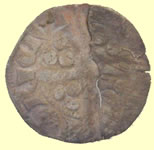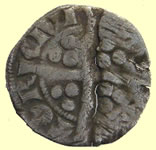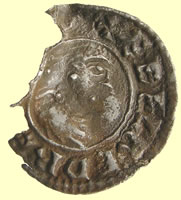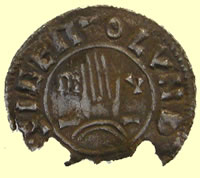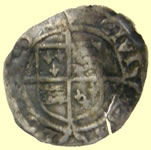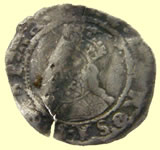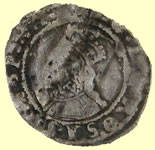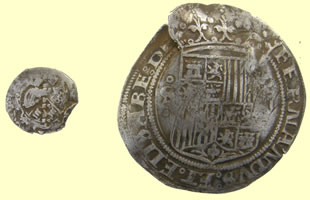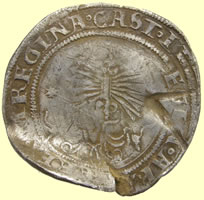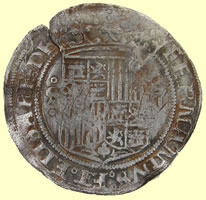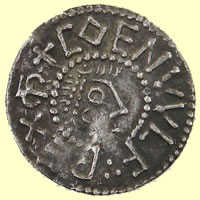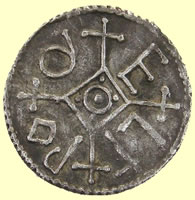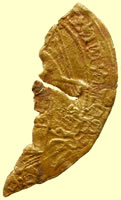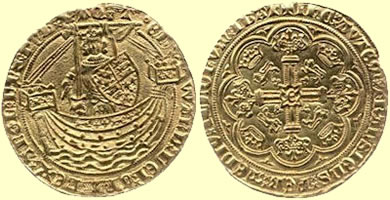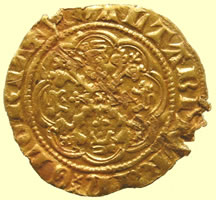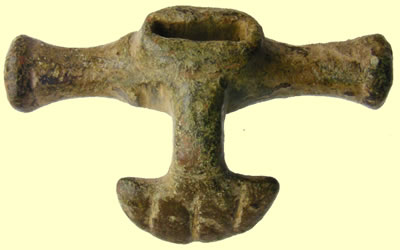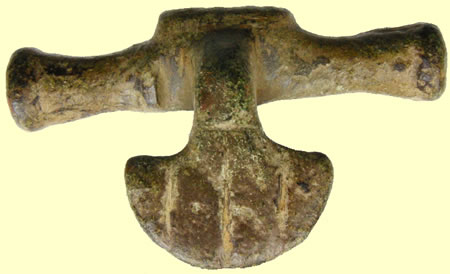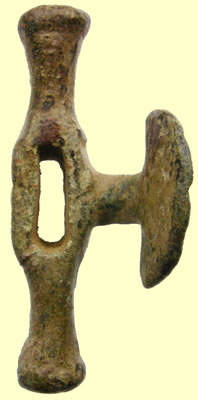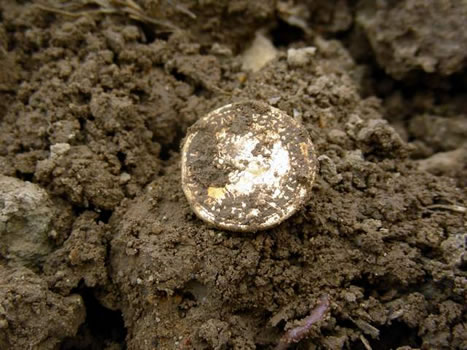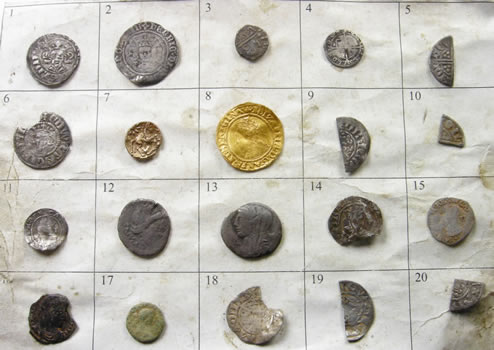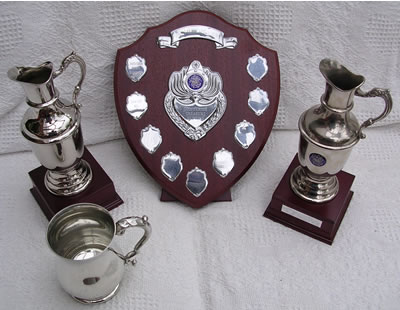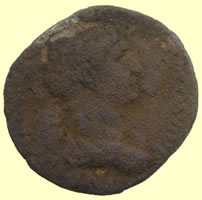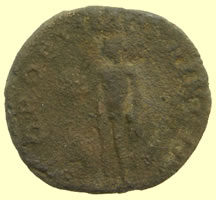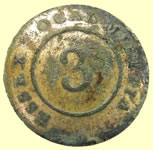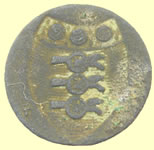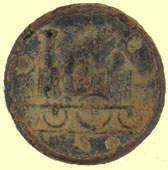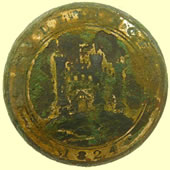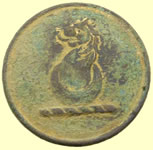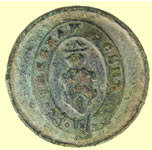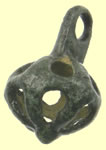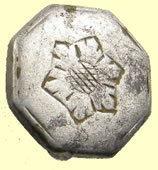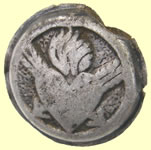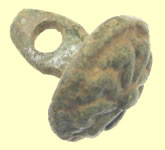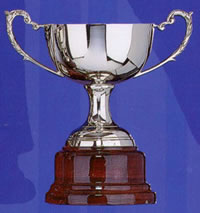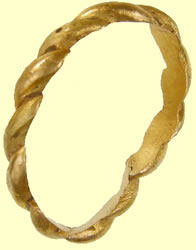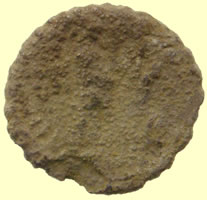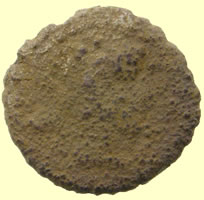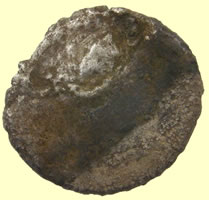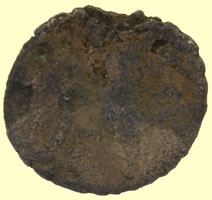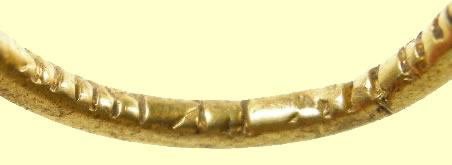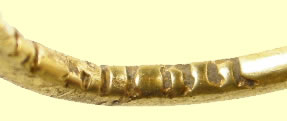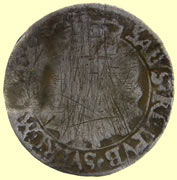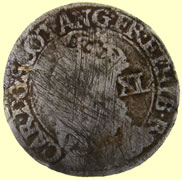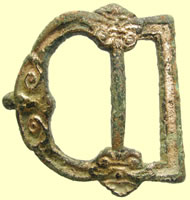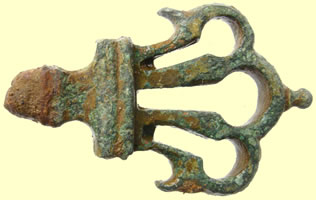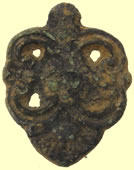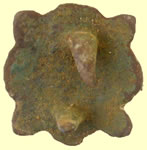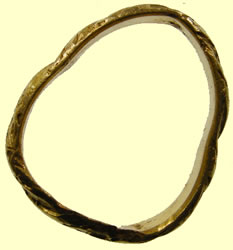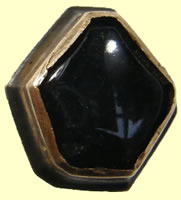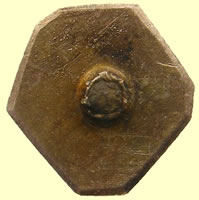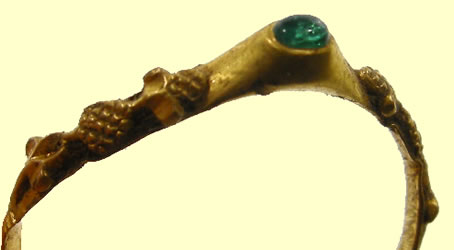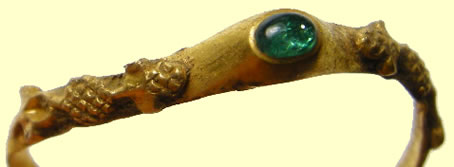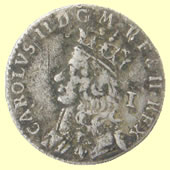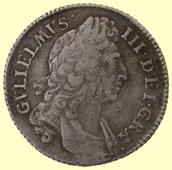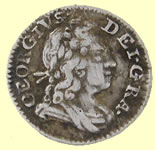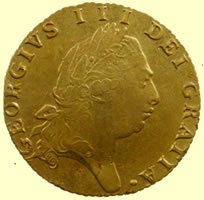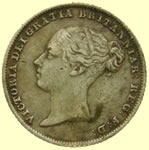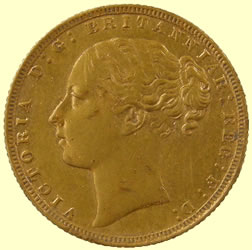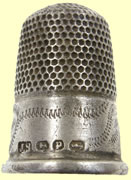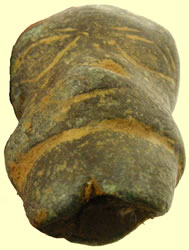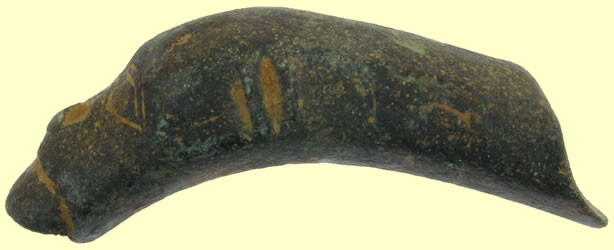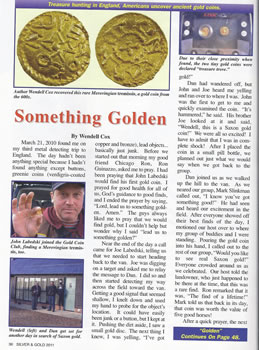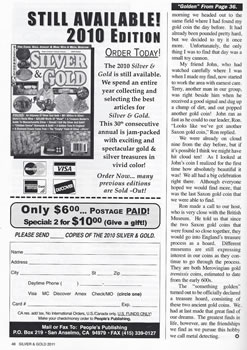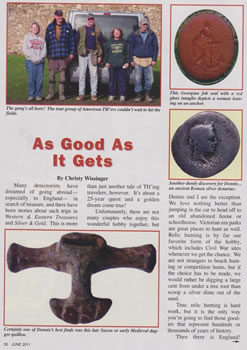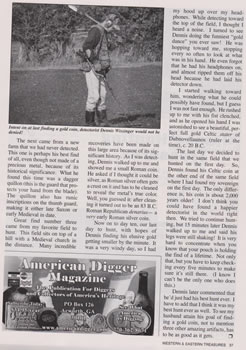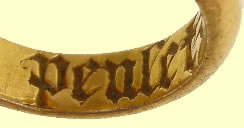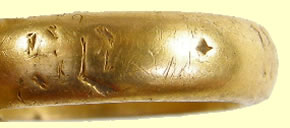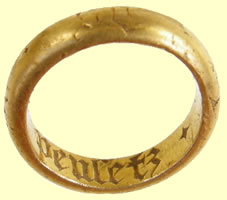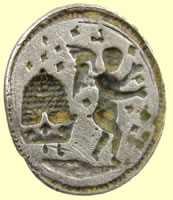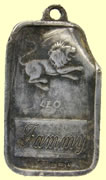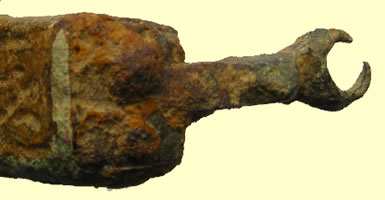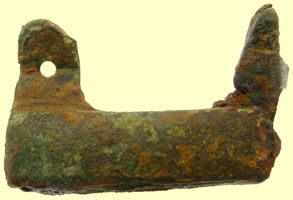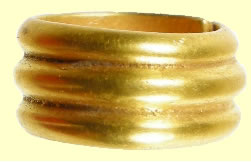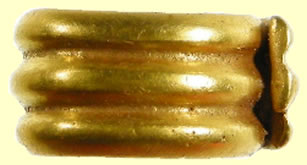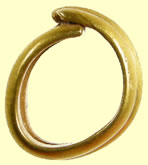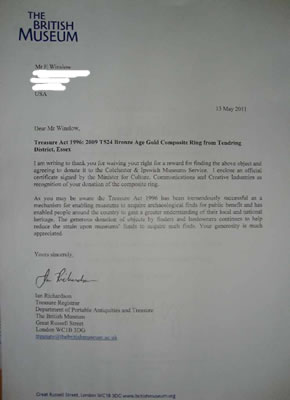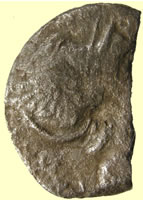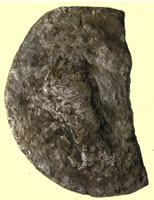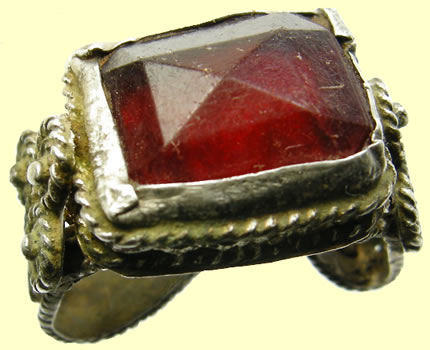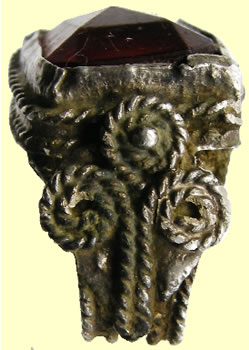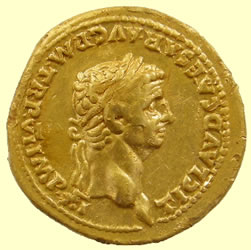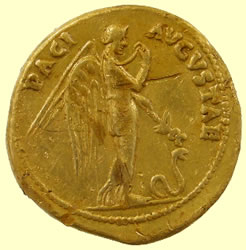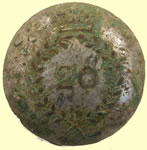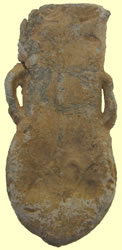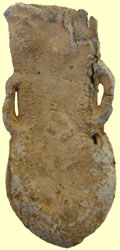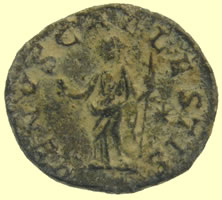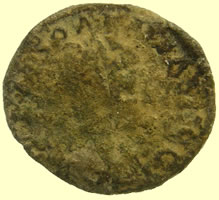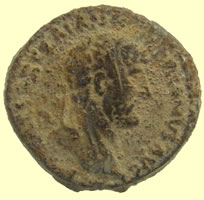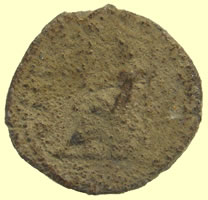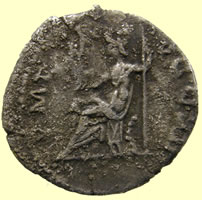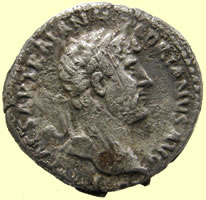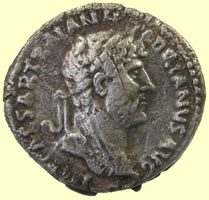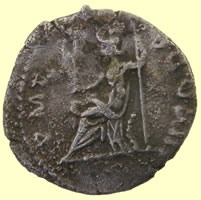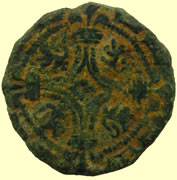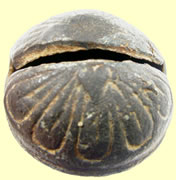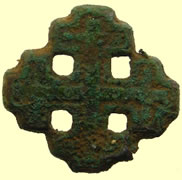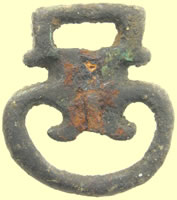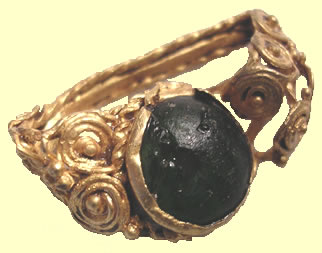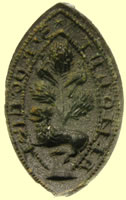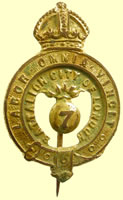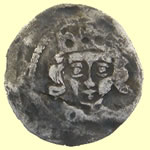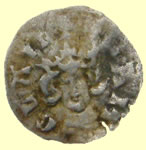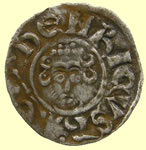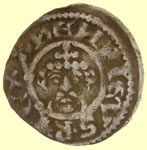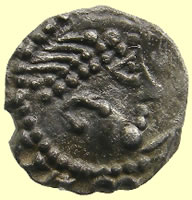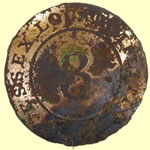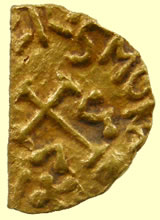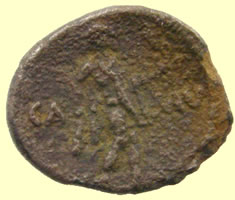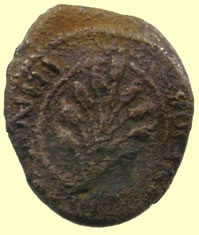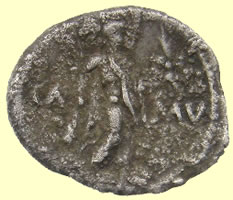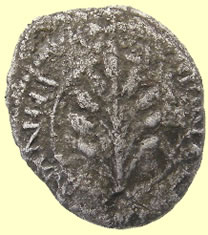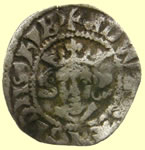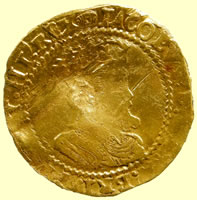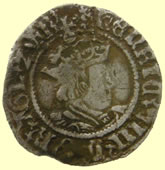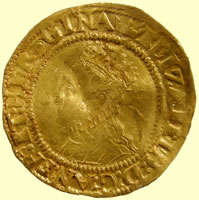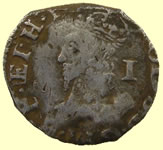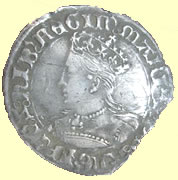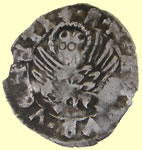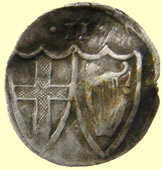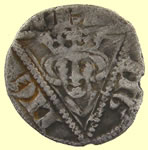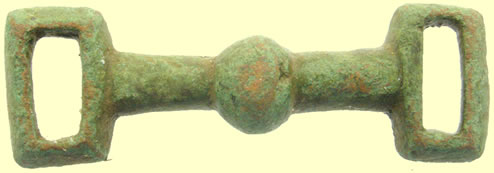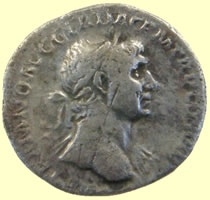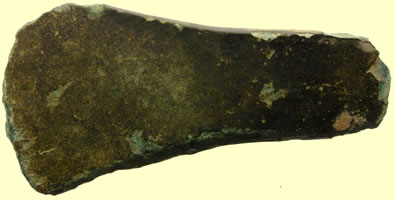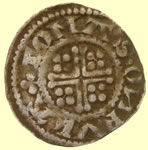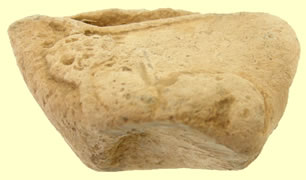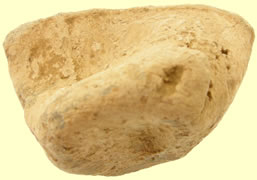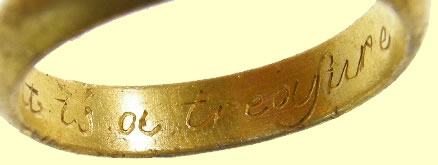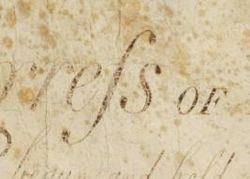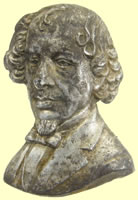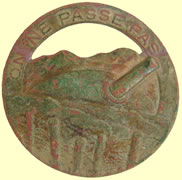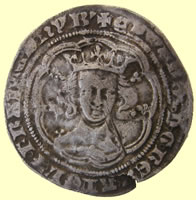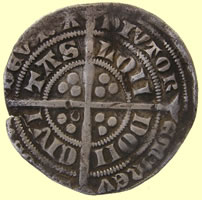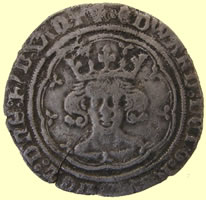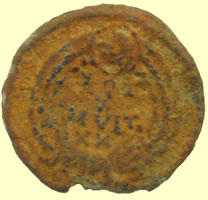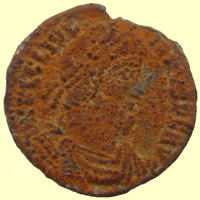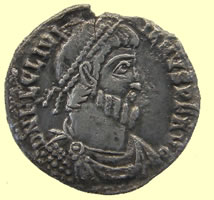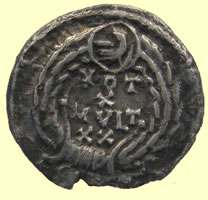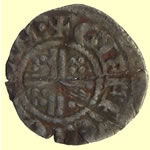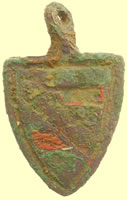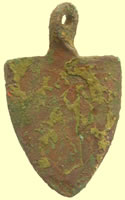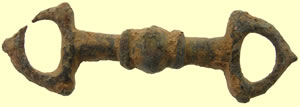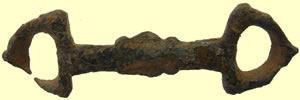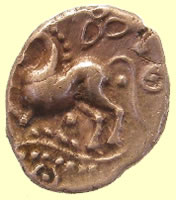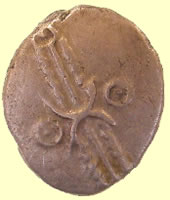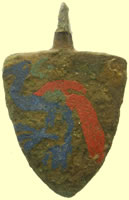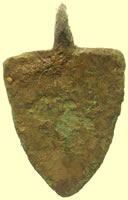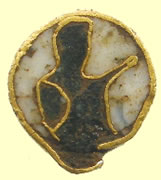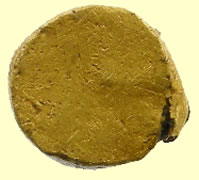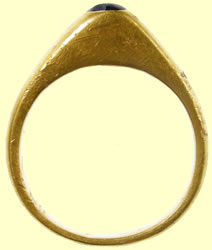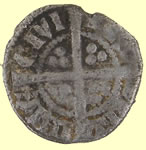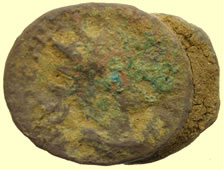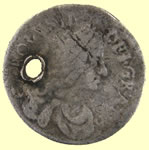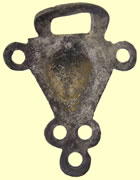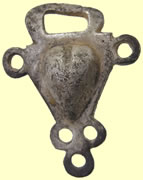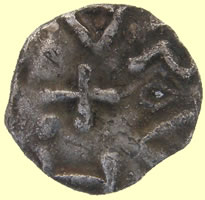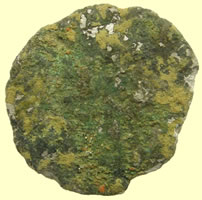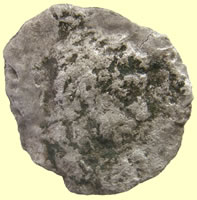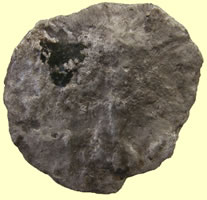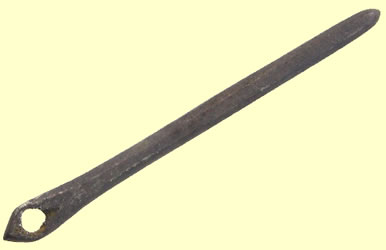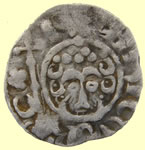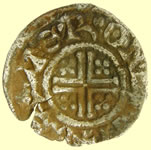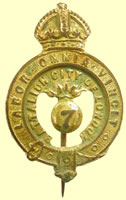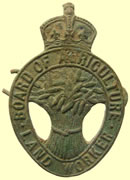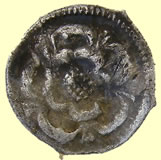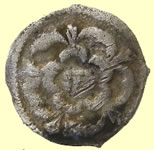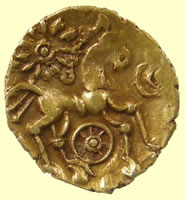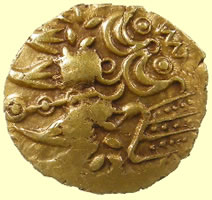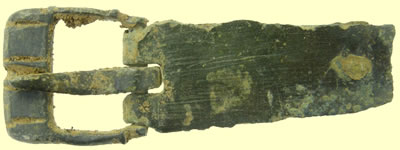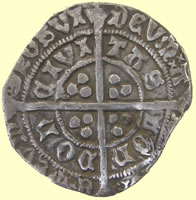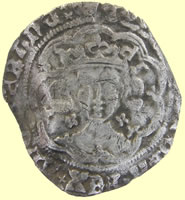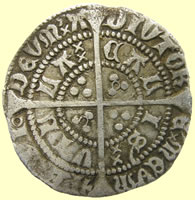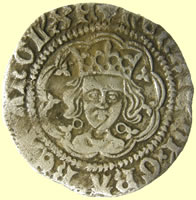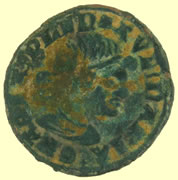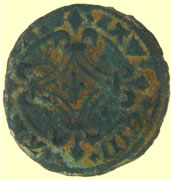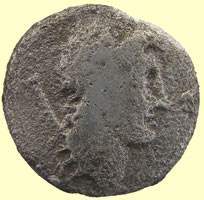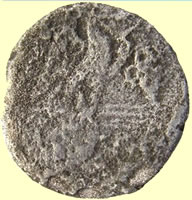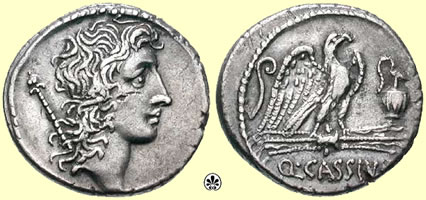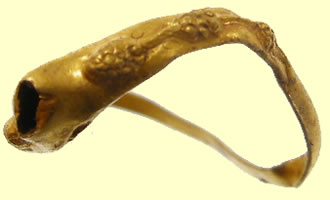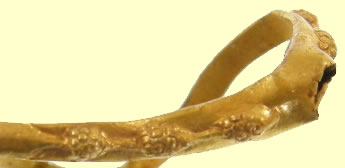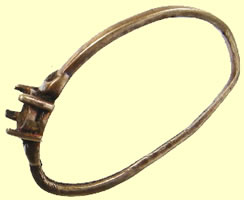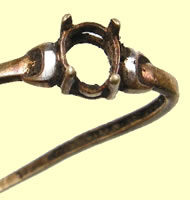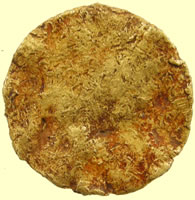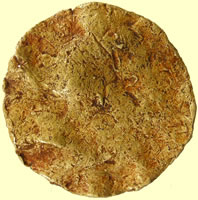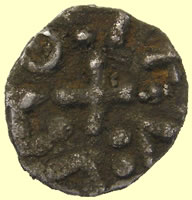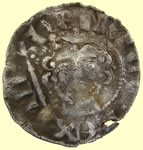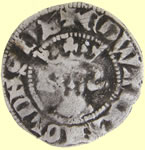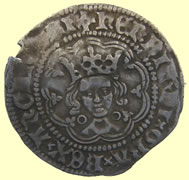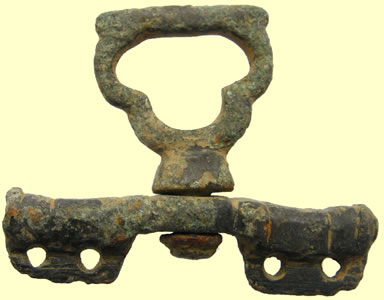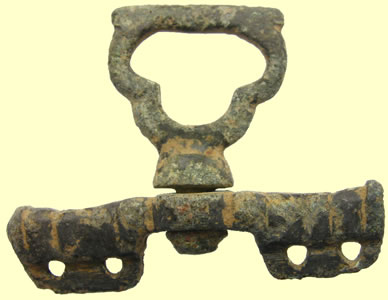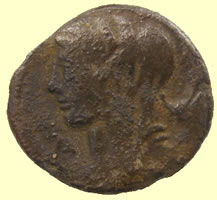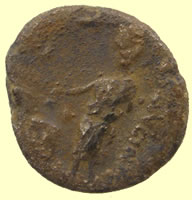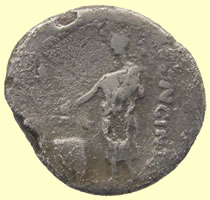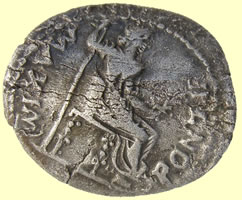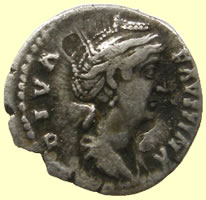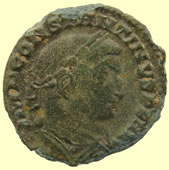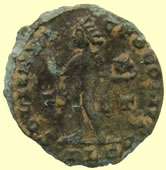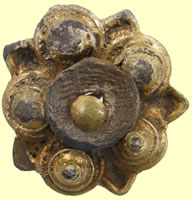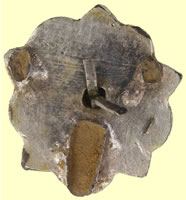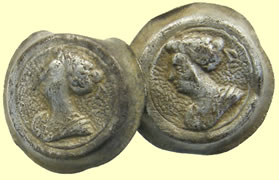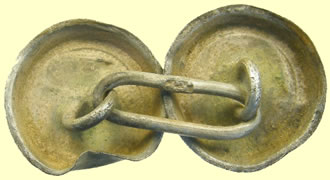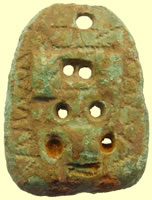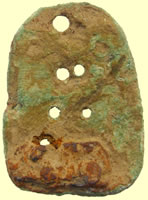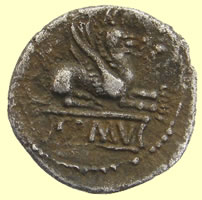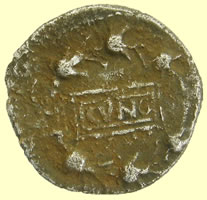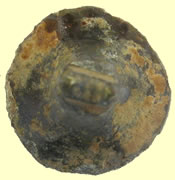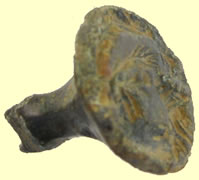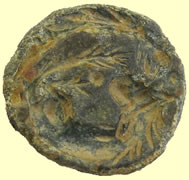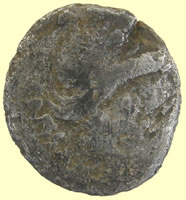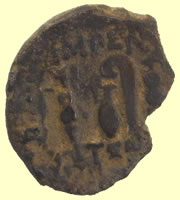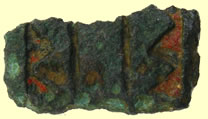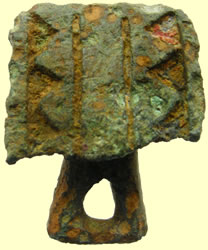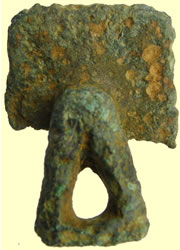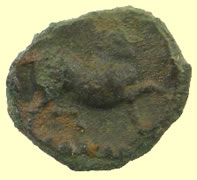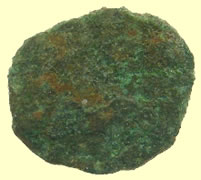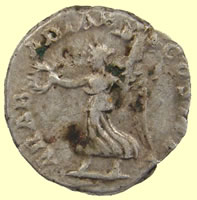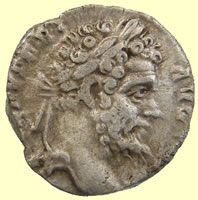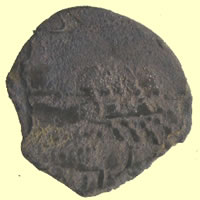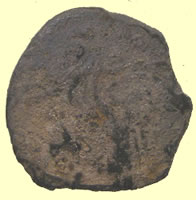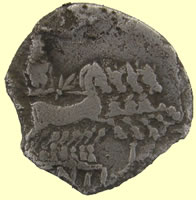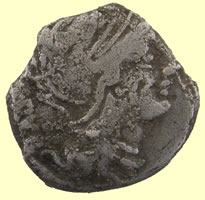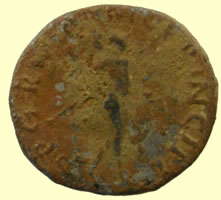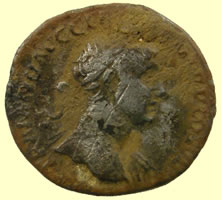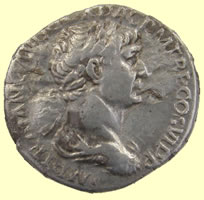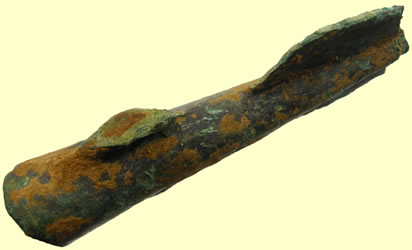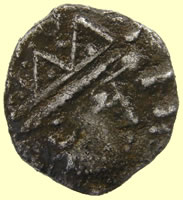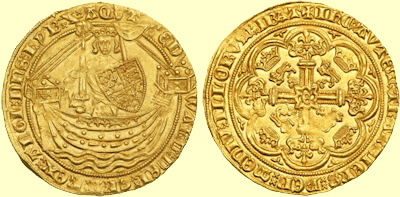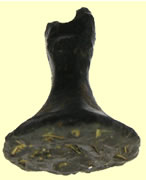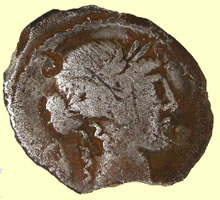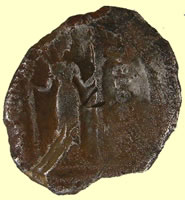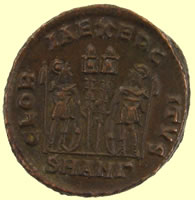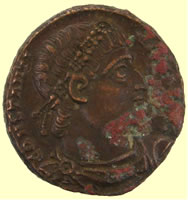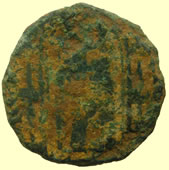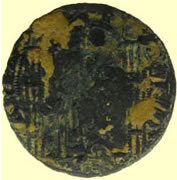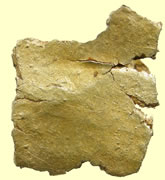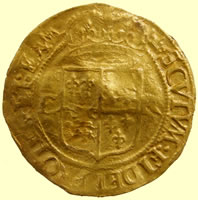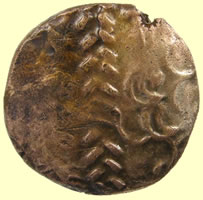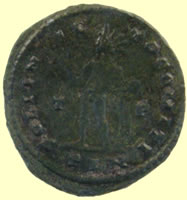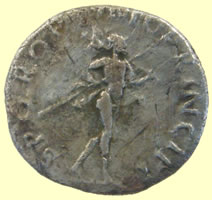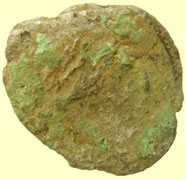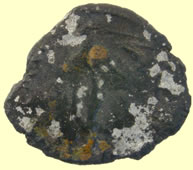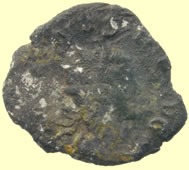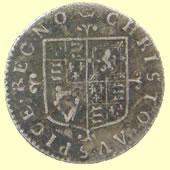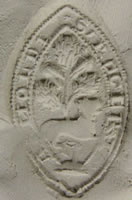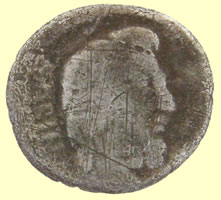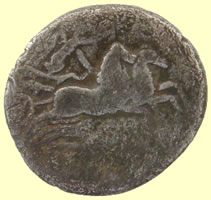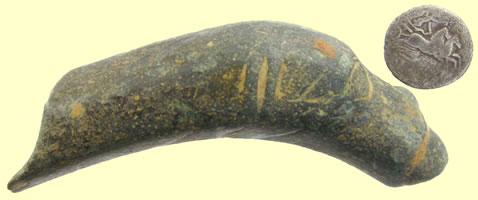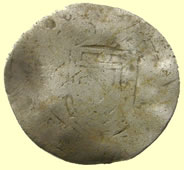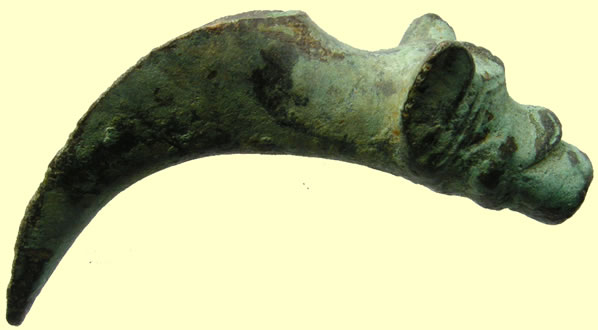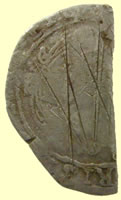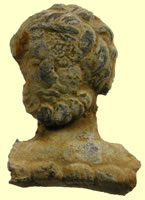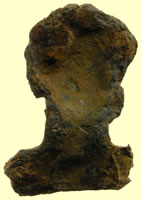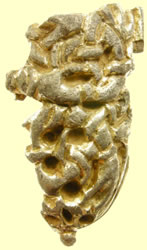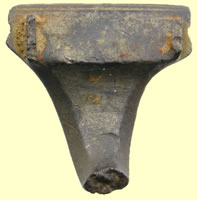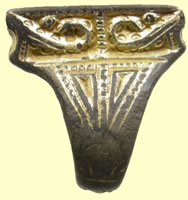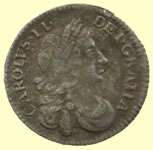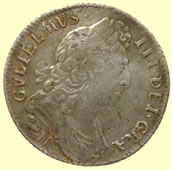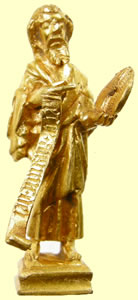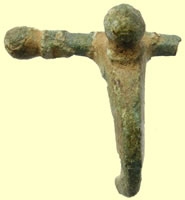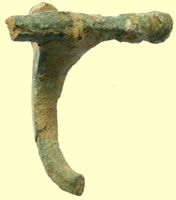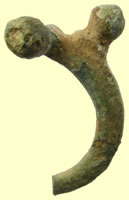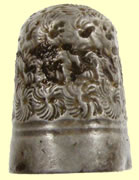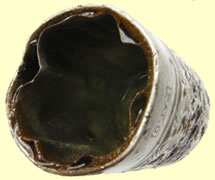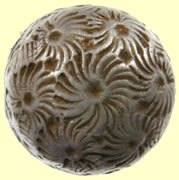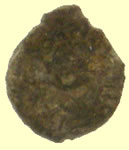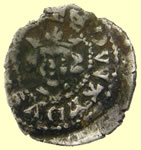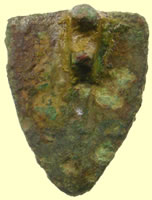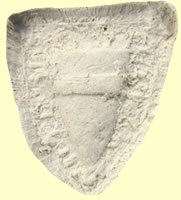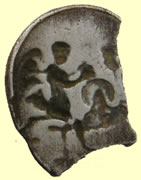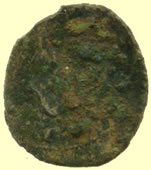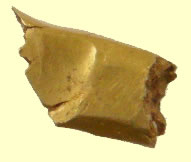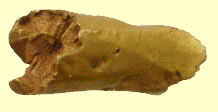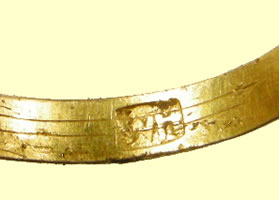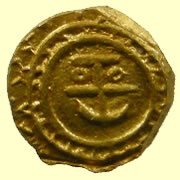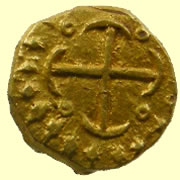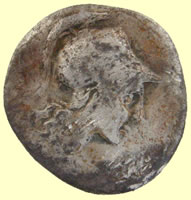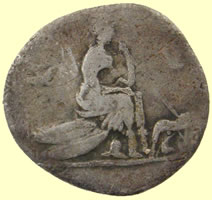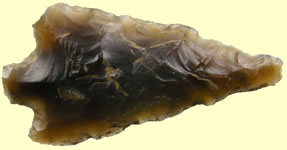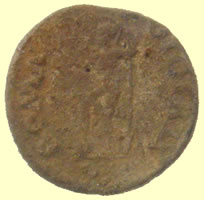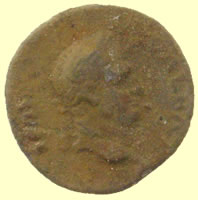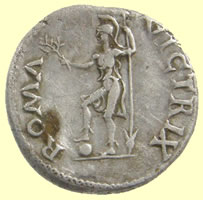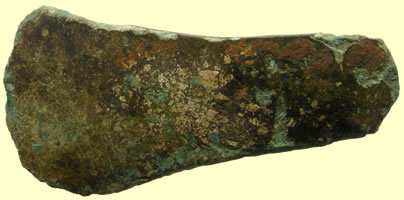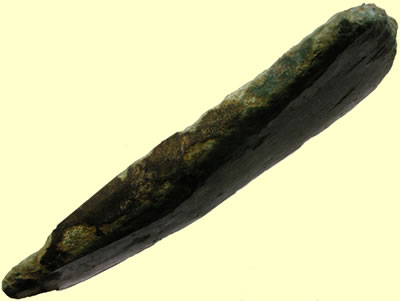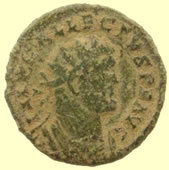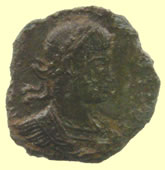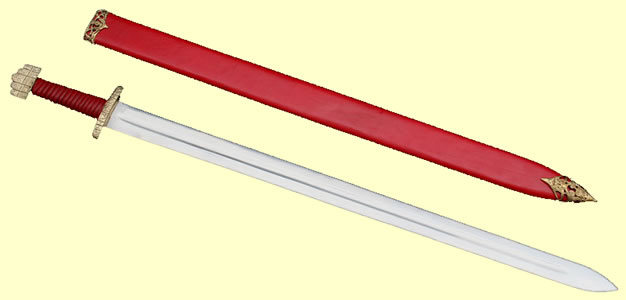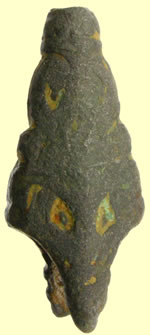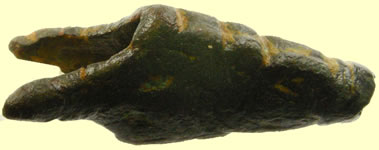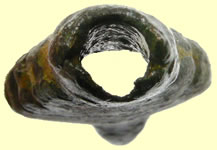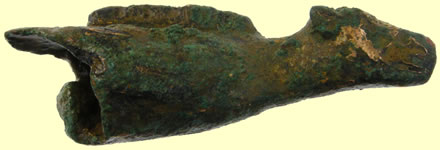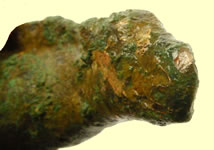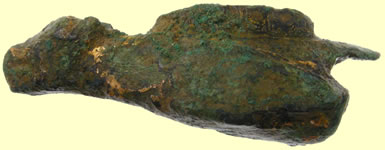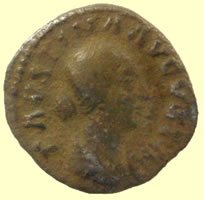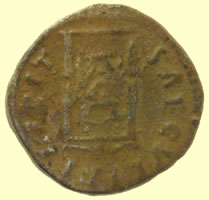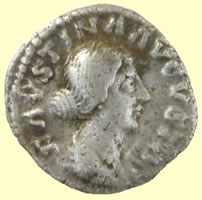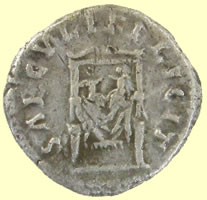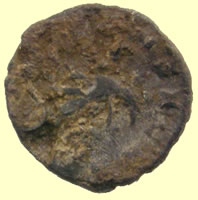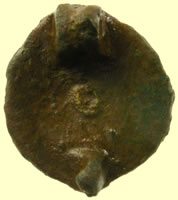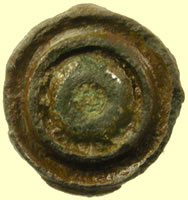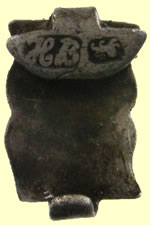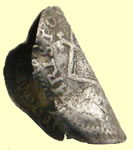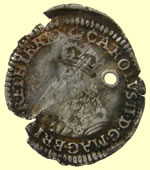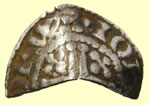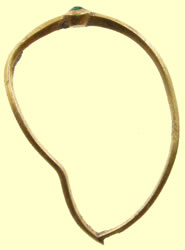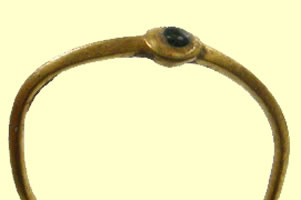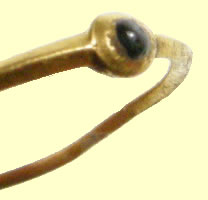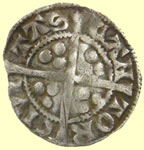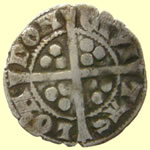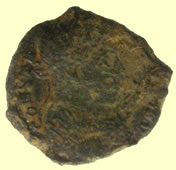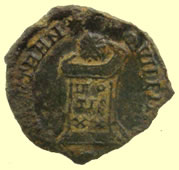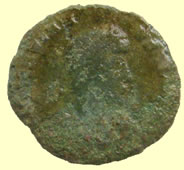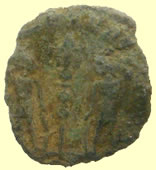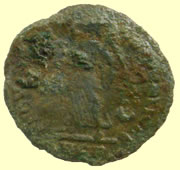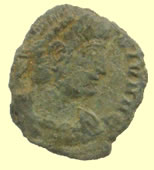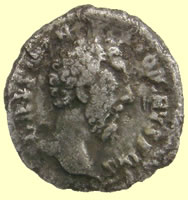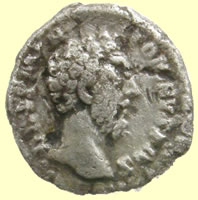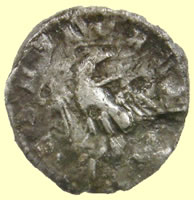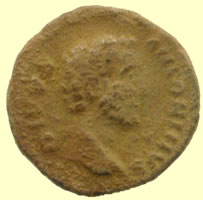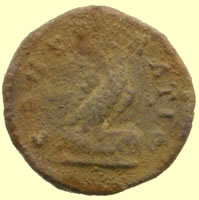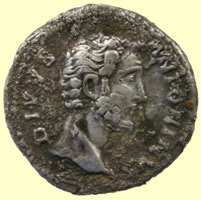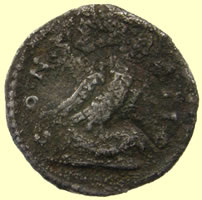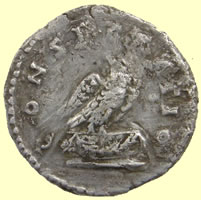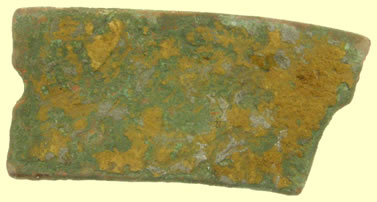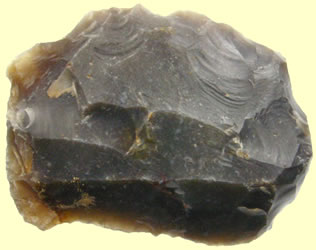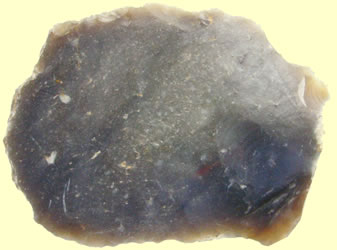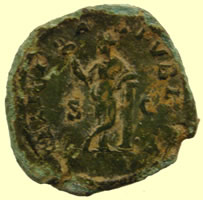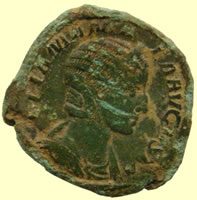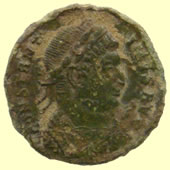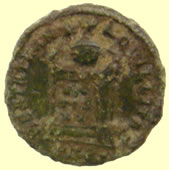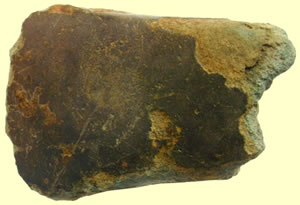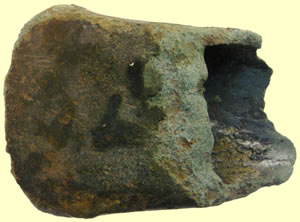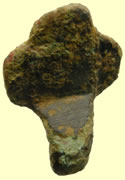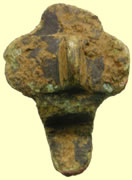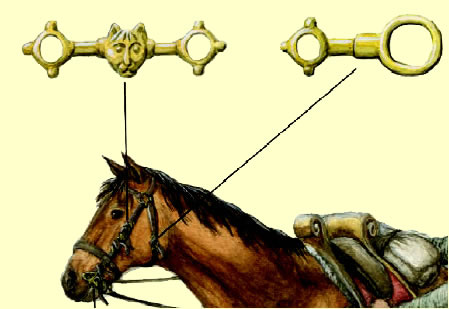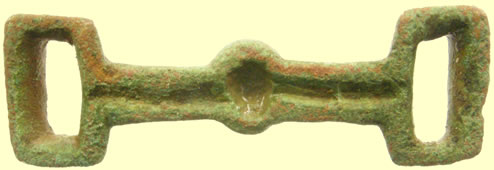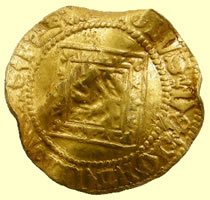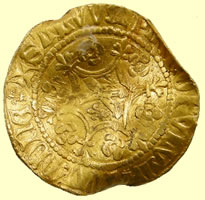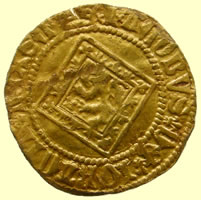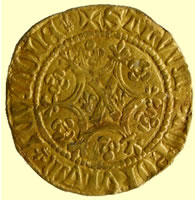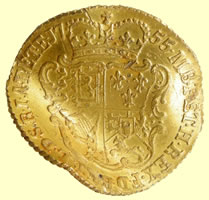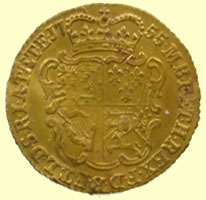

Metal detecting holidays in England with the World's most successful metal detecting club.
Twinned with Midwest Historical Research Society USA
2011 Feb to Aug - Latest News Archived |
28th Aug 2011 6 days to the kick off - Free forum comp entry, 2 days to go Under a week now to the off and the weather is still perfect, warm with plenty of rain to moisten the already ploughed and rolled fields. This time of it can be too dry and we pray for some rain but I just checked the land and it is brilliant digging. Make sure you have sent in your guess for a chance to win the free trip next season. Closing date for entries is 30th Aug so drop me a mail with your guess and I will add to the official entry sheet on the free forum comp page . Check also your guess has been entered successfully if you have already mailed me. This comp is open to any member or any new member already booked for next season as well. More of the guys fixed hammered silver coins are posted below from the first half of the season. I have a bunch more to clean up as they are the grey annealed colour. There are a couple of really tricky ones like the rare Saxon penny that our goldsmith will try to 'cold' roll if possible. Some of the badly taco'd early pennies are particularly tricky being split and covered with stress cracks. The bonus to him being able to open it up is I can now read the legend to ID the type of coin correctly. Updated the coin straighening page
Fully annealed taco'd and repaired 1341 Edward III hammered silver penny florin type Obv EDWAR ANGLE DNS HYB Rev CIVIT/TAS/CAN/TOR - Canterbury mint
Saxon silver penny of Æthelred II 978 AD sent for recording and ID 1.22g,20.34mm This coin (EMC 2011.0084) belongs to the First Hand type (note the absence of a sceptre on the obverse and the plain sleeve without a curve at each side). The Benediction Hand type has two fingers bent in blessing. The moneyer is probably Eadsige or Wynsige. With thanks, Martin
Fixed split 16th C Elizabeth 1st penny
1361 Edward III hammered silver half groat - Treaty period
|
||||||||||||||||||||||||
26th Aug 2011 More fixed coins - annealing More of the guys fixed hammered silver coins are posted below from the first half of the season. I have a bunch more to clean up as they are the grey annealed colour as picked up from the goldsmith. Remember when an ancient coin is bent by the plough which could have been 500 + years ago it is very brittle and if you try and straighten it the chances are it will crack or break in two. Most of these coins are annealed several times to repair the structure before attempting to fix them which makes it go a brown/grey colour which needs to be cleaned off to bring back the colour. 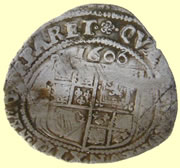 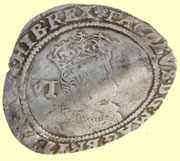  
Bent - annealed and fixed then final cleaning below
1606 James 1st hammered silver 6 pence
Charles 1st penny next to a monster 1474 Spanish 8 reales Spain. Houses of Castille & Aragon. 8 Reales, ND, Assayer D (Seville). Clemente & Cayon-2698; Cayon-2380. 27.40 grams. Ferdinand V & Isabela, 1474-1516. Crowned arms of Aragon and Castille, dividing "S" and small "o" over "VIII". Reverse: Beribboned bundle of arrows and yoke, assayer mark in field.
Perfect repair - UK John's Coenwulf Saxon hammered silver penny - sent to Dr Martin for recording and ID Coenwulf, king of Mercia (796-821)
|
||||||||||||||||||||||||
25th Aug 2011 Fixed members gold and silver pics One week and a day to the kick off !!! Picked up all the fixed hammered gold and silver coins from the 2nd half of the season this afternoon and our goldsmith's work is truely astounding again . NS Andy's disclaimed 13thC medieval gold ring was fractured in 5 places and bent. He rejoined it, using 18 carat gold which matched the original colour of the gold and removed all the deep scratches. Now you cannot see any fractures and it like a new 700 year old ring, amazing work. He repaired a dozen or so badly bent and taco'd silver coins including one broken in half. I have yet to clean them up as most had to be annealed to enable them to be straightened which turns them grey. I have posted the guys fixed hammered gold below and will be posting the silvers tomorrow. The other 2/3rd's of the monster sized full gold noble is still out there on the field to find yet !! Hopefully the fresh plough this year will pull the rest of it up.
Fixed 13th Medieval twisted wire gold ring - disclaimed treasure 22.34mm, 2.73g
Monster sized fragment of a Circa 1327 AD Medieval hammered full gold Noble- ship reverse
Treaty series 1361- 1369 Edward III hammered gold 1/4 noble - Std C type, Double Satire stops - Voided quatrefoil in centre of reverse Obv EDWARD DEI GRA REX ANGL 1.93g, 19.16mm
|
||||||||||||||||||||||||
24th Aug 2011 Another treasure for Ill Mark - Ron's latest vid with Mark finding more gold Added the latest Eastern and Western treasure mag articles about guys trips here to the testimonial page Updated this years forum comp to win a free trip with the latest guesses.free forum comp Another great video with Chicago Ron and Ill Mark + Mindy out hunting for more gold and silver rings. Ron and the guys are true ambassadors of our club returning the rings to the owners wherever possible. Mindy in the past has even returned an 19th gold family crest ring to the living relatives. Ron has his own U Tube channel with all his England and USA trip vids, check it out. http://www.youtube.com/user/chicagoron61 http://www.youtube.com/watch?v=a5DxipGRNvA Remember Ron runs the most successful 'Barn' hunts over here at our club for 6 weeks + a year and he has a few spaces on his 2012 trips. Drop Ron a mail for more info and you too could hunt with Ron and Mark and learn detecting from the true masters of the hobby. Drop him a mail at rpg61@msn.com Please feel free to call me with any questions 773-320-7569 Ron
14.60mm L , 1.71g The export process takes a huge amount of time revisiting every metal object again and photographing each piece for the application of a license. It is amazing how many nice pieces are missed while the hunts are underway especially if lots of top finds are being made by Ill Mark who won 'find of the year' with his mint Roman gold coin and pouch of the year with his triple gold coins. While I was preparing his export pouch I noticed a dirty gold clasp I had not seen and cleaned it up then photographed it in macro. I then transfer the picture to my PC in HD and blow it up by 800 % to see all the subtle nuances, construction and the engraving which looked very early. The Treasure law makes any gold or silver find over 10% by weight a legal requirement to report it to a the museum or Coroner. I always report any 'potential' treasures or hoards to the museum as you loose nothing if the find is returned as disclaimed as not being over 300 years old, base metal or it's dates and location does not constitute a hoard. Normally with a disclaimed treasure you will be given an ID and date so that is a bonus. However in the case of Mark's hinged clasp the curator at the British museum has ID'd the find as Medieval putting within the date range of 11th to 15thC. As with all treasures the curator after receiving the object will complete a full report and it will then go forward for a Coroners inquest. If you are reporting any treasure or hoard the details below have to completed for the museum.
'The British Museum Curators have viewed the images of this and they believe it is Medieval, and as such it will need to be submitted as Treasure. ' Please could you provide the following details so that I can complete a Treasure Receipt and request a Treasure Number Finders Name:
|
||||||||||||||||||||||||
22nd Aug 2011 Latest land update - hunt overview - New medallions Ron and Mark's latest video finding more gold rings More video for a Sat afternoon.Got a call from Anthony in Central Illinois with questions about Minelab, He invited Mark and I down for a hunt with his new Explorer SE. A drained lake that had been hunted for at least a couple months. Gives up Old Gold and silver! 4 gold rings, a silver ring and 3 silver coins plus lots of laughs!
61.54mm L x 35.8mm W, 54.89g Stunning early medieval dagger quillion - finger guard is decorated with a runic inscription I checked all the runic styles and it matches Norwegian the best - one for the museum
All the awards and shields are now with the engravers to be ready for presentation during the season. The engraver guys is making us up several new medallions with a detectorist in silhouette picture he found. I have asked him to produce several different types as test pieces to see which is the best and these will be awarded during the season for outstanding finds and contributions to the club. All the damaged silver and gold coins have been with our goldsmith for a while and should be ready for pick up shortly. I am still waiting for the 2nd batch of approved export license applications to arrive, should be any day now. I have a museum meeting next week to pick up the recent disclaimed treasures and recorded finds from the 1st half of last season. I am hoping they have more info on the medieval dagger quillion above found by Pen Dennis with what appears to have a runic inscription. I took a long drive around our sites to see how the cropping and ploughing is going with just under two weeks to the start of the season. I was amazed to see so many fields ready this early as the weather has been excellent for farmers. Normally the fields are hard and dry in Aug but they are moist and workable. Some of our best sites that had a deep plough for potatoes are already raised and perfect for hunting. New fields will come on line each day up to Nov as more crops are raised, currently we have 300 + fields to choose from. The new 'Woodcutters' 15 fields are still stubble at the moment which is a bummer. We do not hunt stubble here as you cannot get your coil on the ground and 'wacking weed' sucks big time and kills your arm. Remember we do not practise 'sheep herding' here either and you decide which of the fields and sites you hunt each day. Barn groups have their own mini bus and hunt as many fields and for as long as they want each day. Detecting teams here are always small with a max of 7 guys and you decide how many hours you want to detect each day between you. Hard core teams will hunt from 7am to 10 pm each day to get max time out there on the fields. Barn leaders will take older members back to the accommodation early if they want leaving the hard core guys out there with their night lights. The club has total flexibility when it comes to your tour as it is your holiday. Normal hunt times are 8.15 am on the fields and around 7pm finish but guys will vary that depending on the weather. Warm Sept evenings the guys will have several late nights to 9pm as it is still light out there. There is a max travelling time of 15 minutes from the accommodation to the land so you don't spend hours travelling either. My job is to take care of all the logistics, finds photographing, ID'ing, reporting treasures and hoards to museum and preparing all the export paperwork at the end of your tour leaving you free for max detecting out there. Good luck to all the members and 'newbies' with the fast approaching season. Last season we had our best ever on record with 50 gold finds but the guys will be working extra hard to beat it.
|
||||||||||||||||||||||||
19th Aug 2011 Ill Mark and Can Ryan win the awards - 2 weeks to the kick off
The voting was very close this season for 'pouch of the year' with Tenn Brad and Ill Mark only seperated by 2 votes in the end , Chicago Ron got 3rd place. 10 world class pouches were voted for so it was no landslide this year but in the end it was Mark's triple gold pouch, Celtic gold, Elizabeth gold crown and the clincher had to be his mint Roman gold coin find and the beauty Saxon sceat helped. Currently Mark's Roman gold is with Spink auction house so the preceeds can be split between farmer and finder. So what a season for Mark, he did the double with 'find of the year' and now 'pouch of the year' as voted for by the membership. Chicago Ron has posted his latest vid of finds from his team's England March 2011 hunt. It is Ron's biggest vid yet running for 48 minutes and captures most of the gold and silver as it is dug out in the field in March. There are some classic moments as Ron drops his Celtic gold find and Mark finding his gold !! http://www.youtube.com/watch?v=EEbP2TsNpBY
Can Ryan has won the 'coin hunter of the year' award with a total of 85 coins in the week. His pouch included his 2nd Edward III hammered gold Nobel coin and 7 silvers so a great result. He also managed to beat a whole team of fellow Canadian's during that week with the best finds. Ottowas Greg made a really neat shield with an embedded gold coin as the 'Canadian hunter award, so Ryan did the double also this season.
Ryan last season holding his 'Canadian hunter' shield he also won by beating his fellow Canadain team
Voting for this season free forum comp is well underway and 50 members got a double bonus guess this season. Check out the official entry page and rules for you chance to win a free trip next season. Official entry sheet is on the comp page free forum comp With just two weeks to the kick off to the start of the new season I am busy getting everything ready for the off. I have one last meeting with the museum to pick up recorded finds and disclaimed treasures next week. All export pouches have had applications made and the 2nd batch of approved export licenses are due back any day now. All our bent and damaged coins and artefacts are with our goldsmith undergoing repair. I have to visit our engravers now to get all the existing trophies and shields ready for presentation this season. I have already ordered up a new set for the coming season. Details of awards and prizes up for grabs are on the Awards page. 4 new reference books I ordered have arrived for the clubs library. The Roman Republican BC book will come in very handy considering the dozens of BC Roman silver coin we have been finding on just about every field we have. The 2nd book is a specialist time scale AD 284-337 Vol IV in the series. Two new Saxon books with great full coloured illustrations to help us ID the tricky Saxon finds we have been making. Can't have enough ref books !!
Roman Coins and Their Values: The Republic and the twelve Caesars, 280 BC-AD 96 Roman Coins and Their Values (Vol IV)
British Artefacts Volume 1 - Early Anglo-Saxon by Brett Hammond British Artefacts Vol 2 - Middle Saxon & Viking by Brett Hammond.
|
||||||||||||||||||||||||
13th Aug 2011 Phew !! Last of the exports uploaded - Florida Don wins the free trip - Roman silver ID's back Finally finished the last of the export license applications and man what long haul. I have been preparing them for 5 months as every metal object found here over 50 years old must be photo'd and individually itemised on the applications. It is such a valuable exercise looking at every piece again to make sure nothing was missed while the hunts were underway and to do more research on tricky objects. Remember every export application's full pictures and finds lists are posted on the members forum so you can see what every single guy found during their trip. You can go back and review every single export to help you make your decision on what to vote for in this season 'pouch of the year' award. Remember the laws on exporting are very strict and you risk a huge fine and imprisionment if you are caught smuggling finds out of England so always do it properly and get an export license. Table 3 Category of Object OGEL limit
In a very close run contest Florida Don has just won this years forum competition with the final total of ancient coins dug hitting 480. It was right down to the last pouch to decide who won the competition. Big congrats to Don on his free trip win. Voting for pouch of the year is underway and the official voting list is posted on the members forum. 7 different pouches have been voted for so far and there is no clear winner yet so keep them votes coming. Every member that votes gets a 2nd free 'bonus' guess at this years forum comp to win another free trip next season. Official entry sheet is on the comp page free forum comp Mark Lehman has sent back the ID's of the latest Roman silver coins with some very interesting observations. Ark Mary's Roman silver below has really cleaned up really well and has a fascinating write up from Mark.
I'm not 100% sure that I remember what I may have told you about this coin before, but it is Trajan (98-117 AD) the obverse type is Trajan's laureate bust right, draped and cuirassed, seen half from back - this is interesting since this exact bust type is not given for this reverse in RSC (which is generally the major authority on silver). Legend is IMP TRAIANO AVG GER DAC P M TR P COS VI P P. Reverse legend is SPQR OPTIMO PRINCIPI (this legend is common to a couple dozen reverses with different devices) and we seem to have Genius, naked, standing facing, head left, holding patera over altar and corn-ears. I'm a little unsure about the "bulges" on the reverse - to the right of Genius' feet and above the patera - usually that sort of thing indicates a "subearatus" or fourree - a contemporary copy made by wrapping a copper core in thick silver foil, then striking it - but this piece has had enough digs and dings that I can't imagine the silver being thick enough that the core would not have been exposed. What happens is that the copper may corrode under the silver and push it up into bulges which look like these - but I see no other indication that this is anything but a solid-silver official coin. Of course, if it were a fourree, that would explain the unpublished combination of obverse and reverse. So, unless you can see some evidence of it being a silver-wrapped copper core, it's a little unusual in a couple of ways. Mark
Okay, yes, the detail now exposed will change (or add to) what I said before. It is still Antoninus Pius (138-161 AD), but the reverse type is APOLLINI AVGVSTO and shows Apollo standing left, holding a patera in right hand and lyre in crook of left arm. Now that the obverse legend is clear, ANTONINVS AVG PIVS P P TR P COS III, we can date it to 142 AD. As is common for almost all silver coins in this era, this is a product of the mint at Rome, RIC III 63b. Mark |
||||||||||||||||||||||||
11th Aug 2011 More exports uploaded and new forum competition launched - voting time for awards Mindy arrives in Chicago Tomorrow for a 4 day Ron and Mark detecting holiday!
I have just launched the 2011/12 free forum comp to win a free weeks detecting next season. Full details are on the free forum comp page. This year we are going to count all those pesky buttons we dig so it could be a huge number. As usual send me your guess by e-mail and I will add it to the official entry sheet on that page. Closing date for entries is 30th Sept.
This season the were were so many monster pouches made by the members that it is almost impossible to pick the winner. Voting is taking place on the forum by members for their favourite pouch and the closing date to have your say is 17th Aug. Every export pouch with full pictures and finds lists since Sept are posted on the forum so go back thought them to refresh your memories.
I still also have to work out which member dug the most coins in the week for the 'coin hunter of the year' award. I should be able to announce it this week so I can go and get all the cups and shields engraved. I only have a couple more export pouches to process and I will then be announcing the 2010/11 season winner of the free holiday next season. It is very close with the current total at 473
Our current walkie talkies are the cheapy Motorola units that do not have the range or clarity for our needs. The batteries never last and they constantly go wrong. Roaming over 300 fields the guys need to have reliable clear communication especial if they find hots pots and need to call their team over to help grid the area. I have therefore purchased a dozen top of the range walkie talkies for this seasons hunt including these clever 6 way chargers that monitor the condition of the batteries. These are serious pieces of kit as used by the emergency services with crystal clear reception and amazing features. They are totally waterproof and you can even send text messages to each other. The problem is they require a proper radio licence which I have applied for but it will be several weeks more until it is issued. You cannot use these radios without this licence and tuning to the correct radio frequency so it does not cause interference. There are serious penalties for using one of these without the correct licence. Motorola - Motorola Mototrbo Digital DP3600
|
||||||||||||||||||||||||
8th Aug 2011 More exports uploaded and Roman silver cooking Some of these Roman silvers have been 'cooking' since Oct and the detail is finally starting to show through. They still need more 'cooking' but the crust on these was nearly 1/8th inch thick and it is just a case of patiently removing the horn crust layer by layer. I took a large picture of the 1/2 silver that has been cooking now for 11 months and it really shows clearly the thickness of the crust and underneath it appears to have great detail. These are Roman republican coins around 100 BC so well worth the effort to be able for Mark Lehman to date them and for the members collection. Uploaded more full finds lists and photo's to the members forum of the completed export pouches. I have updated the current ancient coin total for the free forum comp = 469
I dropped off the latest batch of bent hammered silver and gold coin members finds to our goldsmiths. NS Andy is also having his disclaimed 14th C medieval twisted gold ring find fixed so it will be interesting to see how it turns out.
As dug by Can Bill
4 months cooking and now 6 months on the detail is emerging
This was just a lump when Wendell dug it dug and now the detail is showing through and you can clearly see a BC Republican type head
Disclaimed hoard coin found by Mass Gary turned out very crisp after a good cooking - sent to Mark again for a revised ID now he can see the legend The denarius seems to be Antoninus Pius (138-161), I'm not certain about the reverse type yet, but it might be a Fortuna type, I seem to make out "FORTVNA" on the left. Antoninus was a prolific producer of types, we'll need to be able to read at least a few letters of the legend on the reverse to be more sure.
Mark
BC Republican coin found by Mass Mike - 10 months worth of 'cooking' and the detail finally showing through, note the thickness of the crust still after all the 'cooking'
|
||||||||||||||||||||||||
2nd Aug 2011 More exports completed - Saxon hoard on display in the USA Just a month now until we re- open for the start of the 2011 season with all the existing land and another new plot taking the total of fields well past 300 to choose from. We have a 2nd new plot to add from Feb 2012 so plenty of fresh plots to search in both halves of the new season. It is going to be extremely hard matching last years record levels of finds including the 50 gold total the club made but the guys will give it their best shot. I will just about finish all the export paperwork and the guys will start digging it again !! Staffordshire hoard coming to the Stateshttp://www.thisisstaffordshire.co.uk...ail/story.html Mitch Chris
I have uploaded more export find sheets and pictures to the members forum including some 'newbie' hunters that did extremely well last season. I have updated the current ancient coin total for the free forum comp = 440. It is getting very exciting as I do the last 20 pouches and someone in the list below will probably win the comp and the free weeks trip.
More disclaimed treasure letters received from the British museum including Ill Mark's Tudor dress fitting - Treasure Act 1996: 2010 T255 Post-Medieval silver-gilt dress fitting from Colchester District, Essex
|
||||||||||||||||||||||||
25th July 2011 Colchester guys & gals kick butt with gold in Alaska - Mark's Wall Street Journal vid
Check out 'find of the year' winner Ill Mark's vid that The Wall Street journal just posted Current total for the free forum comp is now = 427 While I have been here slaving hard preparing export licenses a load of the senior members have been having a fantastic trip gold hunting trip in Alaska at the Ganes Creek mine trailings. Mindy kept the members informed via the forum with a blow by blow daily update and man did they kick butt. They started their trip with a few days fishing and caught some monsters as well. Gene also had other great news while he was up in Ganes as his medieval gold ring find from 2009 has been disclaimed by the British Museum so he gets to take it home. It was certainly Gene's week for gold and these members between them have found over a dozen rare gold items hunting here so their ears are well tuned to big nuggets!!
Treasure Report: 2009 T110 JPR/EM A Medieval finger-ring consisting of a single loop, flattened, with an inscription running along the narrow internal surface. Much of the inscription is illegible, but the remainder appears to read: TOUT ??E ?E VOUS CE ??UE The language is French and the disposition of the words characteristic of late medieval love tokens. The finger-ring is gold and dates from the fifteenth century. Dimensions: external 22 mm, internal 18 mm. Consequently, in terms of age and as the object contains a minimum of 10% precious metal it qualifies as Treasure under the stipulations of the Treasure Act 1996.
Colchester club Senior members Dave, Gene, Mindy , and Tom
Gene's 5 ounce nugget
Tom collection of gold included a beautiful specimen nugget
Gene finds for the week totalled over 9 ounces, and included |
||||||||||||||||||||||||
18th July 2011 Yet more exports - gold nugget hunting
1350-1354 French - King on Horseback coin weight for ‘franc a cheval’ of Jean II
1637- 1642 Scottish Charles 1st machine made forty pence silver coin - Briot's issue- XL by bust
Obv CAR.DG.SCOT.ANG.FR.ET.HIB.REX Rev SALUS REIPVIBLICE SUPREMA LEX - Crown over thistle
Interesting gilded medieval tweezers with suspension loop
Still busy preparing and posting more export applications. Uploaded a load more finds pictures and lists onto the members forum including Bill and Dan's Saxon silver pouches. Dan's pouch included a load of firsts for us as a club. First 1554 Queen Mary base penny, first Scottish Charles 40 shilling and a great bonus find in his pouch our first 1350-1354 French - King on Horseback coin weight for ‘franc a cheval’ of Jean II. Current total for the free forum comp is = 411 A load of the senior members are off gold hunting in Alaska, Gary, Geo and Steve are at the gold mine they bought a couple of years ago. Mindy, Tom and Gene are at Ganes Creek hunting for that 1 pounder nugget. Mindy sent me an update and they have found gold already and caught some nice fish. Mindy is going to send me some pictures of the trip and the gold !!
|
||||||||||||||||||||||||
8th July 2011 More exports and approved licenses arrived - £11 billion treasure found - 4.5 ct ring returned to owner I just received the first batch of 28 approved export licenses in the post , I have posted the names on the members forum so you can decide if you want them shipped or picked up on your next trip. I have completed more export applications and posted more finds list and photo's on the members forum. Updated this years free forum comp page with the latest ancient coin total = 404 Chicago Ron has posted his latest vid below. I am still updating the individual pages with the finds from the 2nd half of the season and have completed the ones below. The buckle page is massive and needs to be split into individual date ranges on separate pages to speed up loading. I have partially completed the ones for mounts with an index linking to individual classifications.
New Ron video on the tube. Returned a 4.5 ct Diamond ring set today!I met Ron Shore from Windy City Detectors at the beach to search for a lost ring. The woman had lost 4 rings from her pants pocket after changing. She found 2 of them right away and spent a week with a rented detector looking for the other two. I started just casually walking the beach as she had not arrived yet. $11 billion treasure revealed beneath temple in IndiaWe've been digging in the wrong country. Time to branch out to the subcontinent . . . Vir John
|
||||||||||||||||||||||||
3rd July 2011 More updates and exports - interesting facts and figures More updates to individual find pages from the 2nd half of the season finds. I have just updated the early milled coins pages and the overall numbers are very interesting for the rarer Kings and Queens. Your are 7 times more likely to find a Celtic gold coin than a Charles II milled silver, 15 times more likely than a James II and a staggering 100 times more likely than a milled silver William and Mary coin. The gold from this period is also like hens teeth and we have never found any. Even an early George 1st silver coin is a very rare find and only 9 examples ever found an one gold coin. The predominate early silver finds are the 1696/7's William III's and George III 'bullheads'. The bulk of the early milled gold coins we have found are George III with a just a single example of a George 1st and only two from George II's reign.
Posted more export finds lists and pictures onto the members forum. Just posted NS Andy's monster triple ancient gold ring pouch. Forum comp is getting closer to win a fee tripTotal is currently 392 with around 25 export pouches still to photo, count and process. Final total should be between 450 and 500 as a guess.
|
||||||||||||||||||||||||
26th June 2010 Load more exports - 'pouch of the year' ?
Still banging away preparing export applications from the 2nd half of the season. Loads more uploaded in full to the members forum including Ill Mark's which has the potential to win this years 'pouch of the year' award. Mark found three gold coins on his trip and he has already won 'find of the year' for his Roman gold find. The landowner is taking both the Roman gold and Saxon gold coins to Spink to put them in a specialist auction as they have a very high estimated value. The finder and landowner will split the profits 50/50. Mark also found two BC Republican Roman silvers and a Saxon sceat + 9 other pages of silver and great relics. The members this year will be voting for their favourite 'pouch of the year' as there have been so many amazing pouches it is very difficult to call the overall winner. Once I have posted the final export application pictures on the members forum guys will be asked to submit their personal favourite. Chicago Ron and Ill Mark have been out hunting the Chciago beaches and found an amazing number of gold and silver finds last week. Ron has posted his latest vid on U Tube http://www.youtube.com/watch?v=7RtzGlAOQF8&feature=player_embedded New video up.
Updated this years free forum comp page with the latest ancient coin total = 384
|
||||||||||||||||||||||||
17th June 2011 Wendell's and Christy's stories - more land on offer - donations I just got an e-mail in from one of our existing landowners who's mate that owns the farm next to his is interested in our club searching his plot from Sept. I have sent him all the information on our club and a copy of the contract for his perusal. Hopefully he will be contacting me further so I can go and take a look at the fields. Some of the land is in the centre of the village which has great Bronze age and Roman potential.
I have just had a couple of e-mails from the local museum replying to guys offers of donations of key finds. Wash Tom wants to donate his superb Medieval barrel spout and the museum are delighted at the offer. The donor signs a transfer of title form and the find will be displayed with the donators name along side it. Another two great articles from club members hunting here in this and last months months Eastern and Western magazine. Wendell submitted the one about his Saxon gold hoard coin find. The museum are currently acquiring it as it was declared part of a hoard at Chelmsford Coroners court. Penn Christy wrote a great story about her last trip with husband Dennis where they seriously kicked butt as a team. The Saxon looking dagger quillion is still with the experts at Colchester museum being recorded and evaluated.
Click on the pages to view full size.
Wendell's Saxon gold hoard story - click on thumb nails for larger image
Uploaded a load more export find lists and pictures to the member forum. Updated this year free forum comp with the latest ancient coin total = 339
Dennis and Christy's monster hunt - click on thumb nails for larger image
|
||||||||||||||||||||||||
12th June 2011 Improving your game video - more exports posted - more disclaimed treasures
Spain. Houses of Castille & Aragon. 8 Reales, ND, Assayer D (Seville). Clemente & Cayon-2698; Cayon-2380. 27.40 grams. Ferdinand V & Isabela, 1474-1516. Crowned arms of Aragon and Castille, dividing "S" and small "o" over "VIII". Reverse: Beribboned bundle of arrows and yoke, assayer mark in field.
1634 Charles 1st hammered silver penny Uploaded a load more export find lists and pictures to the member forum. Bav Jeff had a monster sized Spanish silver hammered in his export pouch he had not show me, I have posted it above. I took a picture of it next to one of Jeff's other hammered silver penny's for size comparison. Updated this year free forum comp with the latest ancient coin total = 336 I am constantly asked why our club is the most successful in the world and even the museums are amazed at our high rate of recovery rate especially with treasures and small gold coins and objects. This year we beat the club record again and found 50 gold finds. The simple answer to our success is skill, dedication and continuous practise. Our top senior members are world class and in a different league than the average detectorist who believe it is mostly luck. It is 75% skill and 25 % luck not the other way around as most guys like to think. Our club has a core group of senior members that can dig more noble metal targets in a morning than an amature can dig in a whole week. Any 'newbie' coming here can take full advantage of these top members and improve their game by 500% easily. The clubs finds rates increase every year as 'newbies' get better and better with help from the top guys. One of our top 5 hunters in the club is Chicago Ron and he has put together a great video of how to make yourself a home test garden to improve your game. It clearly shows how just a few simple settings on your machine can make the difference to not hearing the target to digging it. These guys can dig big copper coins in compressed fields at 15 inches and the tiny whisper signal hammered silver coins. If you seriously want to improve your game then follow Ron's very detailed vid. Do the same with hammered silver coins and see just how faint and crappy the signal is at depth.
Ron has also posted his latest vid when he found his first 24K gold ring. I just got a couple of new e-mails in from the British museum and two finds have been disclaimed and are being returned to finders. Mark's medieval gold love ring and Boris's stunning 17th C seal matrix. Both finds will be ready for collection shortly.
Treasure Report: 2009 T579 A Medieval finger-ring of D-shaped section with inscriptions on the external and internal surface. The inscription on the outside of the hoop has seen much wear and is largely illegible. It appears to consist of the following letters: SE NA R SE?L The inscription on the inside of the ring is crisp and legible and spells PENSETZ This is a variation on the French word ‘pensez’, meaning ‘think’ (of me). This single word is often deployed on rings with romantic inscriptions. The ring’s proportions suggest that it may have been worn on the small finger of a slender woman or by a child. The ring is gold and dates from the fifteenth century. Dimensions: internal diameter 18 mm Consequently, in terms of age and as the object contains a minimum of 10% precious metal it qualifies as Treasure under the stipulations of the Treasure Act 1996. J P Robinson
Stunning 17thC seal matrix - disclaimed
Neat St. Christopher medallion - Inscribed Tammy
|
||||||||||||||||||||||||
5th June 2011 More exports - donation letter
Superb medieval barrel lock Still busy working my way through the export licence applications and uploaded a load more find lists and photo's to the members forum. Mitch Chris has a great bonus find in his pouch, which he did not show me at the time and it is an almost complete medieval barrel lock.
Min Mindys export sheets for the 2nd half of the season are the biggest I have ever processed. Her finds pouch weighs in at a massive 5.171 Kg, covers 17 - A4 pages on my export application and the file I e-mailed to export duty was 3 Meg in size. Or Ed just sent me a great letter he got from the Heritage manager at Colchester museum for his generous donation of the 1300 BC gold ring, looks like it will go on temporary display shortly for all to enjoy.
Click on letter to enlarge
|
||||||||||||||||||||||||
27th May 2011 Ed's donation letters- oldest club coin record beaten 146 BC - hoard discovered locally Click pictures to read more A collection of Roman coins has been unearthed by archaeologists excavating a former barracks in Colchester. Two pots, one of them containing 1,247 coins, were discovered on the site of the former Hyderabad and Meeanee barracks, which are being redeveloped. The coins, known as antoniniani, date back to between 251 and 271 AD.
Monster find -Circa 1300 BC Bronze age gold open backed triple banded gold ring 3.48g, 13.73mm dia x 6.74mm H Reported to Colchester museum as treasure - declared treasure at inquest and donated to museum by finder and landowner
On display at British museum
Click on the certificates to enlarge Org Ed just sent me copies of his certificate from the British Museum acknowledging his and the landowners very generous donation of the 1300 BC gold ring he found. Hopefully it will be on display in the near future at Colchester museum for all the members to visit and enjoy.
146BC Roman silver Republican coin Mark Lehman has finally managed to get an ID on the silver Roman coin Min Mindy found in Nov that I have been cooking ever since. It had the hardest crust I have ever seen on a Roman so I knew it was early. I am still 'cooking' it some more to see if I can get any more reverse detail. However Mark has dated it as 146 BC making it the clubs oldest ever coin find by 10 years Acting on a hunch, I think I might have found something adequately similar in order to provisionally date this piece. I still can't make heads or tails out of the reverse of the broken denarius, but the letters behind the head of Roma look a lot like # 219/1d & 219/1e on this page: http://davy.potdevin.free.fr/Site/crawford3.html - I suspect that even if yours isn't this precise type, it is at least of similar age - which also, I believe, makes it one of the earliest Republican pieces you've found. Mark
Great news as I just received a letter from the Colchester museum , Col Bruce's silver ring with red stone has been disclaimed as treasure by the British museum so he gets it back.
|
||||||||||||||||||||||||
25th May 2011 Ill Mark wins find of the year - more exports and museum meeting
1st place - Ill Mark's 'find of the year'
2nd place NS Andy's 1st to 4thC Roman decorated gold ring with green stone - currently with Colchester museum going through the treasure process 20.01mm,1.43g
The member turn out was nearly 100% for voting for their favourite 'Find of the year', great support by the club. The winner by a huge margin was Ill Mark's stunning Roman gold coin find with 73% of the vote, the rest of the votes were spread over 9 other items. 2nd place was NS Andy's gorgeous Roman gold ring with emerald. Mark wins a fully inclusive free trip next season, Roman silver urn trophy and his name on the shield of honour. I dropped the last of the reported treasures and hoards to the museum yesterday so they are all now going through the process. The previously disclaimed Roman bronze hoard coins, that I expected to pick up to return to the finders, are still not back from the British museum yet. Also finds deposited with the museum for recording in the first half of the season were not ready for collection either. I am still working my way through the export applications but it is going very slowly as some of the pouches are massive and I have to photgraph missed finds while the hunts were underway. Min Mindy had 25 sheets of finds to picture and list just for her 2nd half of the seasons hunts. Finds for the club are at a record high due to the constantly improving skill levels and the new generation of machines the guys are using. Updated this year free forum comp with the latest ancient coin total = 264
Pilgrim ampullae - holly water bottle made of lead 12th to 15thC, These ampoule were brought from pilgrimage places as a souvenir Mitchiner suggests that many ampullae were used in the annual springtime ’Blessing the Fields’ ceremony, in which the Holy Water they contained was sprinkled on the ground to give prayer for a good harvest. Having served this purpose, Mitchiner suggests that the ampullae were discarded. Others have suggested that the ampullae were buried along with their contents for a similar purpose.
|
||||||||||||||||||||||||
21st May 2011 More updates, cooked Romans and exports
Updated a load more individual pages with finds from the 1st half of the season, posted below. I did more work on our 'cooking' Roman silver coin finds and the scare Julia Soaemias is coming out really good. I have sent it off again to Mark Lehman to see if his provisional ID changes now he can see a clear legend. Can Bill's very BC Republican silver Roman has a crust as hard as rock and the detail is only just starting to show after 3 months in the 'cooker'. Back in to the 'cooker for more work but you can make out a standing animal on the obverse. Currently the clubs oldest coin record stands at 136 BC and this year we got close on several occasions but we keep hoping someone to beat it. If you want more info on 'cooking' Roman silver coins then check out the coin cleaning page on this site. Both Ron and Mindy have already booked their 2012 & 13 season dates for their 'Barn' hunts. Full details are posted on the members forum or you can contact them direct for more info. Mindy has 8 booked weeks and Ron 6 weeks so there are a few available slots if you are quick.
|
||||||||||||||||||||||||
19th May 2011 Saxon gold valuations - more exports - database updates
Merovingian tremissis of the 7th century 1.26g,15.08mm The treasure valuation committee sat recently and has already sent out offers for several of our declared treasures and hoards. Ill John's Saxon gold coin is valued at £3500 and Wendell's Saxon at £1800, this is a great result for both the landowner and finders as they split the find 50/50 by law. I have finished uploading our hammered gold finds to our searchable database and if you type in the search box 'Celtic gold' you can see we have made our 95th Celtic gold coin find this season, amazing total. You can search our database by any key word. http://foundintheground.com/search/SearchResults.aspx?q=celtic+gold&s=21 http://foundintheground.com/photos/hgc/default.aspx - Main hammered gold page Updated this year free forum comp with the latest ancient coin total = 195
Voting for 'find of the year' is progressing well with 80% of the members already registering their choice. The closing date for voting is 25th May so you have just 6 days left to have your say. Uploaded more export pictures and finds lists to the members forum. Added a load more coins to the two new Roman pages under construction. 1st to 2ndC Roman bronze coins 3rd to 4thC Roman bronze coins
|
||||||||||||||||||||||||
15 May 2011 New Roman gold page and Ron's new 48 minute video
Chicago Ron has posted his latest vid of finds from his team's England March 2011 hunt. It is Ron's biggest vid yet running for 48 minutes and captures most of the gold and silver as it is dug out in the field in March. There are some classic moments as Ron drops his Celtic gold find !! http://www.youtube.com/watch?v=EEbP2TsNpBY I am still updating the site with all the finds from the 2nd half of the season and created a new Roman gold page to reduce the load on the main Romano/British coin finds page. I still have mega amounts of work to do to sort out this page as it is really messy and too huge. I need to create a separate Celtic gold page. We now 8 separate Romano/British pages and I have added two date ranged Roman bronze coin pages to make finding stuff easier and improve load times. New pages under construction 1st to 2ndC Roman bronze coins 3rd to 4thC Roman bronze coins
|
||||||||||||||||||||||||
13th May 2011 More exports complete and site updates- FTY votes Keep your votes for the 'find of the year' coming in, closing date for voting is 25th May. It is very important for all members to cast a vote to be eligible for next years free forum competition to win a free trip. Drop me a mail. More exports uploaded to the members area with full find lists and photo's. I have updated the individual find pages below with the 2nd half of the seasons finds. Updated this years free forum comp page with the latest ancient coin total = 211
|
||||||||||||||||||||||||
9th May 2011 New Henry III page and more exports
I have finished a major revamp on the early hammered silver pages as they were getting too huge. I have created a new Henry III silver coin page and included the date ranges for all the various classes of these coins. Henry III is the silver coin issue that transitions from short cross silver to long cross to prevent 'clipping'. I have separated the issues on this page and also into cut halves and qtr pennies with some more history on the coins. I have updated the King John and Edward III pages with the latest finds. More exports uploaded to the members area with full find lists and photo's Updated this year free forum comp with the latest ancient coin total = 195. Remember as I complete each guys export pouch this number is updated
|
||||||||||||||||||||||||
7th May 2011 More huge page updates Created a new Saxon coin page to reduce the size of the main Saxon page which was huge. We now have 3 individual Saxon pages, one for coins, harness fittings and other relics. All the 100's of other individual find pages are listed on the Finds menu page. I have updated the pages below with finds from the 2nd half of the season. This season we added a few more 'firsts' to our collection of numbered Military buttons and we have almost a complete set from 1st to 100th regiment.
|
||||||||||||||||||||||||
6th May 2011 Busy with exports - criteria and reminders - Cooked silvers
Monster find C600 AD Merovingian gold reported as hoard to museum and sent off to Dr Martin Allen for ID 0.87g, 12.39mm As usual this coin (EMC 2011.0059) is Merovingian and not Anglo-Saxon, but an important find nonetheless. We have recorded two cut halves of Anglo-Saxon gold shillings in recent years, and a cut half of a Series B sceat, but this coin is noticeably more than a half (between two-thirds and three-quarters), so it may have been cut up as bullion. This is developing into a really interesting hoard. Best wishes, Martin I should have mentioned that there is no obvious match in the works of reference on Merovingian coins, but the inscriptions are legible, which gives some hope of identification eventually. Martin I made a start with the export preparation and have posted full find sheets and photo's to the members forum. Each man made object must be photo 'd before submitting the export application to the museum. That includes every musket ball, copper coin etc over 50 years old. This is gonna be a long process this year as some of these pouches like Tenn Brads take up 15 A4 sheets and each item must be listed. Note finds like Brad's Saxon gold coin do not appear on the export sheets as that is with the museum as part of a hoard. Only disclaimed treasure items can appear on an export license application so Brad's other silver bodkin needle and 17thC silver button treasures are not listed. Check the exporting page for full information and laws
1. 1247 Henry III hammered silver voided long cross half penny
1. Irish 1279 Edward 1st hammered silver penny
More cleaned up and ID'd ancient coins
Roman silver coin straight into the 'cooker' sent for ID I'm afraid at this point I can't tell you much more than that it's a denarius of Hadrian (117-138 AD.) Which of the many possible seated deities or personifications might be on the reverse I really can't tell at this point - although if, as I suspect, it turns out that she's holding a branch in her right hand, it's likely to be Pax. Mark It is, as I said, Hadrian. I don't have time to look up a catalog reference at this moment, but will do so later today. Mark
As dug, partially 'cooked'
Monster find 10-40AD Celtic Cunobelin tribe silver coin - in the 'cooker' to remove crust 13.98mm, 1.17g rev figure stg.r.,partially draped, holding club in r.hand & palm branch in 1.,to 1.'CA',to r 'MV',pellet border Obv .leaf c inside circle,to r.'CVNOB',to 1.'[ELI]NVS', pellet boarder Similar Hobbs 1897 |
||||||||||||||||||||||||
1st May 2010 Massive uploads More uploads of this season finds to the indivdiual pages below. I have created new pages for both Commonwealth and Mary coins to speed up load times on the other pages. I will have to split further pages like the Edward III into small and large denominations like the Elizabeth pages as they are getting massive.
|
||||||||||||||||||||||||
30th April 2011 Huge updates and exporting The off season is still a very busy period as I have to catch up on updating our web site with all the seasons finds which is a mammoth task. I will also be starting the export process shortly that requires me to empty out each guys pouch, take photo's of every piece of man man objects, type up a detailed finds list and them submit them to export duty for issuing of an approved export license. It is very time consuming but it is still fun finding with all the great bits missed while the hunts were underway. Normally there is an odd Roman silver or 2 lurking in a guys copper coin bag as they did not know what it was as they usually have a thick crust and some are totally green. Our oldest ever Roman silver 136 BC was found in with a guys 'greenies' last season. Don't forget to keep your votes coming in for the 'find of year' award. So far 50 votes have been cast and it could be a landslide victory this year.
Updated the following pages with this seasons finds.
|
||||||||||||||||||||||||
28th April 2011 More of last weeks finds uploaded - Bav Jeff wins 'dedicated' award
Possible Romano/British silver handle 11.84g, 33.36mm w x 41.46mm H x 7.24mm T
Really neat 1920's silver boxing medallion Still catching up on last weeks finds and posted a bunch more to the 2011 April finds page. Penn Dennis had our first ever short cross coin from a Welsh mint in pristine condition in his pouch with a perfect legend posted below. A 1/3 of the membership have cast their votes for 'Find of the year' and it appears two of this years finds have really grabbed guys attention. The voting list is on the members forum. I just received a letter from the British Museum disclaiming Ark Gary's Roman snake handle from last season. The museum have not been able to attribute it to any period and he therefore gets to take it home. 'Although passingly similar to Roman snake jewellery the form, style and craftsmanship are not closely paralled by Roman work. Nor has it been possible to assign the handle to another era or culture'. Ralph Jackson Dept of Pre history , British Museum Mark Lehman has sent back the ID's of the last Roman silver found and one of them appears to be rare. They are currently 'cooking' to bring out more detail so Mark can confirm the ID's.
Bav Jeff has won this years Nova Scotia Greg award for 'dedicated detectorist' of the year. I was in 2 minds as to the winner of this award this season as I had several nominations and have watched several guys that are really deserving of it. But in the end the one that sticks in my mind the most is the week Bav Jeff hunted with Ron's team in Oct. The weather was hideous, rain wind, boot sticker and while Ron's boys were hiding in the bus Jeff was still out there swinging away each day and the last one back to the bus each evening. The decider was even in this hideous weather he was out risking the rough ploughed and popped his beauty George III gold coin, now that is dedication. He was here again with Ron's team in March and even though his wife was in Japan with all their disaster problems he kept swinging away. Popular win judging by all the posts on the members forum.
Having hunted with Jeff a year ago on Ron's barn hunt I know he totally deserves this award. His boots and rain gear didn't arrive and he was still out there swinging in the cold, wind and mud. First to leave the van, last to come in, always cheerful and enthusiastic despite horrific conditions, and his dedication paid off with some fantastic finds. Bravo Jeff! Min Mindy I used to think that I was hard core ,then I met Jeff .Last year his bag did not show up on the plane , the average guy would have been sulking around, not Jeff he was out there in the rain with dress slacks , house slippers , no rain coat , no gloves .It was so cold that day ,that some of us including myself were back at the van trying to figure out how to better rap our stuff up ,my hands were tuning blue from being out there .I remember thinking to my self look at this guy out there he's insane. He never said a word or complained .Congrats Jeff you are the meaning of the words "dedicated detectorist".well deserved! Ill Mark
Stunning example and the first Wales mint we have ever found 1190 -1205 King John hammered silver short cross penny of the Rhuddlan mint - Class ii Obv HENRICVS REX Rev TOMAS.ON.RVLA - Moneyer Tomas of Rhuddlan Wales mint Short cross coins were produced during the period 1180-1215 at this mint
First decorated 1641 Civil War lead powder measure and cap I have seen - looks like a cat design |
||||||||||||||||||||||||
26th April 2011 Voting time for 'find of the year' - Cal Jim wins Wayne Otto award It is that time of the year when the club honours it's valued members with all their hard work, long hours and dedication out there in all weathers. We remember and celebrate our fallen members by also having awards named in their memory. Min Mindy ran the 4th Barn raffle draw last week during her hunt and the name of the winning ticket pulled out of the hat for a free weeks holiday was Org Mary and Clarence, congrats on a great win. Keep an eye on the members forum for the next prize draw to win a free trip. As I do the recent export pouches I will be adding to the total of the free forum compeititon to guess the number of ancient coin found during the season Nova Scotia Greg award for 'dedicated detectorist' of the year Free weeks holiday and Silver Urn for 'find of the year'winner. 'Prolific coin finder' award and Tankard Wayne Otto Memorial cup for the detectorist with the 'best attributes' during the season Forum competition - - free weeks detecting prize 'Pouch of the year' - award and cup
VOTING time is here - get those votes in to be eligible for free weeks holiday comp
|
||||||||||||||||||||||||
25th April 2011 Guys end the season with 50th gold find and Roman silver
Roman silver coins straight into the 'cooker' and sent for ID
It was been boiling out there the last couple of days with temps of 27C and the ground is dry as a bone. However it did not stop the guys having a magnificent end to the 2010/11 season with another gold find taking the clubs total to a record 50 items, smashing last years record of 45 pieces. Col Bruce had a fantastic hunt with his new T2 machine and popped this stonking 17th/18thC gold ring and on the last day and a silver Roman coin. I have reported it as treasure to the museum and updated the Hoard & Treasure page . Min Mindy also finished the hunt will with another crisp Roman silver coin. I have already done huge uploads to the 2011 April finds page with all the other finds but have dozens more to catch up on this week.
17th/18thC gold ring - inscription uses old style long S as a normal S - Maker Rh - no hallmarks 4.41g, 19.66mm Inscription reads 'CONTENT IS A TREASURE' Long style S went out of use between 1782 and 1793 'CONTENT IS A TREASURE'
An italicized long s used in the word "Congress" in the United States Bill of Rights Reported as treasure to museum
Stunning 19thC silver brooch - no hallmarks I wonder if this is celebrating William Wilberforce (24 August 1759 – 29 July 1833 leader of the movement to abolish the slave trade.
Superb WWI find "They shall not pass" (French: "Ils ne passeront pas/On ne passe pas"; It was most famously used during the Battle of Verdun in World War I by French General Robert Nivelle (although some have attributed it to his commander, Philippe Pétain). It appears on propaganda posters, such as that by Maurice Neumont after the Second Battle of the Marne, which was later adopted on uniform badges by units manning the Maginot Line. |
||||||||||||||||||||||||
21st April 2011 More great finds and ID's Col Bruce is having a great hunt and finding some really crisp silver coins, two full groats and that heraldic shield pendant with the red and blue bird motif. Cal Jim is researching the owner with no luck so far. However he has successfully ID'd the one from last week as Sir Hugo de Braundeston, link and shield below. I have finished 'cooking' Bav Terry 4thC Roman silver and it has turned out mint. Posted a few more widgets on the 2011 April finds
Finished 'cooked' pictures of a 4thC House of Constantine Roman silver coin
He is the very last of the Constantinians, Julian "The Apostate" - or "The Philosopher", depending on your point of view - the budding, new Christian Church definitely favored the former since he is probably best known for trying to revive the virtues which existed in Pagan times.
His story is not altogether unlike that of Claudius. A "minor" family member, he was always in the background eclipsed by his more famous cousins, the sons of Constantine the Great. He became Caesar almost solely in name alone in 333. Assigned the administration of the less glamorous Western segment of the Empire, he managed to survive the "purge" of competing family members immediately after Constantine's death in 337 in which his cousins Delmatius and Hannaballianus (among others) were conveniently dispatched and removed from the competition.
He took advantage of the opportunities his position afforded to both educate himself and to become proficient in the arts of war and command, and by not picking any fights - fighting only when it was necessary - he managed to outlive them all. He was proclaimed Emperor by his troops in 360 which brought him into conflict with his cousin Constantius II.
On the eve of battle in this conflict, in which he was badly outmatched and expected to be defeated, he received a summons to parley. Expecting to be taken prisoner and/or murdered, as it turned out, Constantius had died during the previous night and he was instead informed that he was now the uncontested emperor of all of the Roman Empire in 361 AD.
His Imperium was a short one, however, and he lived only another 2 years, dying in a battle with the Sasanid Persians - although his rule was remembered as particularly just and even-handed.
This piece is from his short tenure as Augustus. It's a Siliqua, a denomination introduced in the reforms of Constantine - the first circulating piece in good silver the Roman Empire had seen since the early-mid 3rd century. It appears to be from the mint at Arles, due to the eagle in the medallion at the top of the wreath which was only done in Arles, but the mintmark should be PCONST (P, S or T for the officina designation preceding the CONST - for Constantiniana, the name of Arles at this time), but for some reason, yours doesn't seem to have the officina mark. I'll see if I can find out whether this is a known variation or not.
As dug and repaired 1216 Henry III hammered silver short cross penny - Class 7b-7c Obv HENRICVS REX Rev +GIFFREI.ON.LVND - Moneyer Giffrei of London mint
My best guess would be that your shield is that of Hugo de Braundeston, on Collins Roll 10, number 484. Here is the drawing of that shield, by done by that site. Cal Jim
C10thC Saxon harness cheek piece |
||||||||||||||||||||||||
19th April 2011 More Celtic gold and great relics- amazing weather
Guys out in the warm sun in T shirts !! The weather has been too good out there with 20+C every day making the land very dry, we need rain bad but the fields are still lovely and flat The guys have started the very last weeks hunt of the season brilliantly with piles of widgets of every description including a range of early lead tokens from Roman to medieval. Several top finds include a complete Saxon harness cheek piece, full medieval groat and the amazing enamelled heraldic shield pendant that Cal Jim is now researching and of course another Celtic gold qtr stater found by Min Mindy. This is Mindy's first ever qtr stater of a local chief Dubnovellaunos and her 4th gold coin. Updated this years gold page, 49th gold of the season so far, this is smashing completely last season record gold count of 45. I have a whole bunch of finds from last week still to photo as I have been having problems with my new site editing software which is messing up all the page settings.
Eastern uninscribed Celtic gold qtr stater of Dubnovellaunos, c 20 BC 12.25mm,1.3g
Stunning 13thC Heraldic shield pedant - Blue enamelled bird with red feathers
Early medieval lead token - needs more research |
||||||||||||||||||||||||
18th April 2011 - Special Saxon treasure post- curators report I just received a letter from the British museum on their research on this amazing discovery. Ill Mark found this really interesting enamelled item in 2010 and initially it was very difficult to date. It now turns out to be a very rare Saxon find and the only one of it's design ever found. Below is the British museums curators reports on the item with other examples of this style of work. The item will be going forward to inquest at Chelmsford coroner court shortly.
Early medieval 870-1050 Saxon
Treasure Case 2010 T169 PAS ID ESS -9E6D71 Date Early medieval 870-1050 Saxon
Description Enamelled roundel, with a gold blackplate and a gold outer wall which is perfectly and neatly soldered on, but at one point now torn and distorted. Extremely slender internal cell walls of gold pick out a human figure from the waist up, holding out the left arm with a further curving wall perhaps depicting the right arm are filled with dark green enamel, and there is white opaque enamel outside.
LON-3478C7
This roundel is about the right size to come from a finger ring, and circular roundels of similar size are known from tenth century finger-rings such as PAS-D681D8,LON-3478C7,and two noted in Treasure Annual reports but not on PAS database (TAR2003,no 110, 2003T 24 and TAR2001,No 46;2001T11). All of these depict a four -petalled flower, but different designs are found in base metals on LVPL500 (a four cell pattern with alternating red T-cells and blue mushroom cells) and LON-A2FD02 ( a rectangular field with tow petal shapes). Discussion: Another roundel of similar size, but with a design of the Hand of God, was reported as Treasure in 2006 (T242;TAR 2005/6,no 286) and interpreted as a setting from a larger religious object such as an alter cross, book cover or reliquary. The opaque white and dark green enamels of ESS-9E6D71 are easily paralleled among the finds, but the particular motif,with a hand raised in blessing, and does not appear to have been noted before. The enamelled settings are well known from Continental workshops, but the number now known from the 9th to 11th centuries in England(including very high quality work such as the Alfred Jewel) shows that they are likely to have been made here.
Dimensions: Weight 1.25g, Diameter: 9.84mm Helen Geake National finds advisor PAS |
||||||||||||||||||||||||
17th April 2011 Stunning silver finds and more land- Gold Treasures returned - Gold videos posted Chicago Ron has posted several video's he took of his teams hunt when they found the gold out in the field, great to see the guys reactions when they saw it in the dirt. Ill Mark's gold Roman coin find http://www.youtube.com/watch?v=0q-65uZqTbo Chicago Ron's Victorian full Sovereign http://www.youtube.com/watch?v=LResogotGXc
Medieval gold ring with sapphire - 24.12mm dia, 11.42g - disclaimed and returning to finder
Medieval gold 'love' ring 17.18mm, 4.17g - disclaimed and returning to finder Treasure Report: 2009 T579 A Medieval finger-ring of D-shaped section with inscriptions on the external and internal surface. The inscription on the outside of the hoop has seen much wear and is largely illegible. It appears to consist of the following letters: SE NA R SE?L The inscription on the inside of the ring is crisp and legible and spells PENSETZ This is a variation on the French word ‘pensez’, meaning ‘think’ (of me). This single word is often deployed on rings with romantic inscriptions. The ring’s proportions suggest that it may have been worn on the small finger of a slender woman or by a child. The ring is gold and dates from the fifteenth century. Dimensions: internal diameter 18 mm Consequently, in terms of age and as the object contains a minimum of 10% precious metal it qualifies as Treasure under the stipulations of the Treasure Act 1996. J P Robinson Org Gary just mailed me and he is getting back his medieval gold sapphire ring he found in 2009 as the museum do not wish to acquire it. They are also returning Mark's medieval inscribed French lover ring, great news for the finders. Updated the Hoard & Treasure page with the latest finds I have reported to the museum.
1279-1284 Irish Edward 1st hammered silver penny Rev CIVI/TAS/DUB/LINE -City of Dublin
The guys are still digging great widgets and early milled and hammered silver and I have posted a load more to the latest find page2011 April finds. Mark Lehman has sent back the ID's of the Roman bronze coin finds and I have posted them to that page. Min Mindy found a neat pair of Roman coins fused together so probably from a purse. The landowner came out to chat with the guys and has added yet more new land to his existing portfolio. It is currently in rape so we will have to search it next season. It joins one of our most productive Celtic and Saxon areas.
Great find 2 mid 4thC Roman barbarous radiate coins stuck together 2 coins fused together makes it sound as though there must have been a (cracked or broken) pot or (organic material) purse or bag which although it didn't keep water out, more or less held the coins in place until fairly recently - it takes a while for the diagenesis process to fuse coins together. This could be why you're getting a bunch of radiate copies - a somewhat substantial group which was only scattered relatively recently. At any rate, it seems you're digging a mid-late 3rd century horizon at the moment or an area through which a plow-pass scattered a significant number of similar pieces.
The coin which is facing the camera in your photo of the "twofer" looks as though it might be an official piece from one of the later Gallic emperors, probably Tetricus I - I think I can read [IM] P C TET [RICVS...] and the quality of the engraving doesn't seem like the typical crude work of the contemporary copies. I believe that these and their copies circulated side-by-side for at least a part of the time during which they were current, the copies making up for a shortfall of official coin, even from the "local" Gallic Empire. Since you very seldom (if ever, so far as I remember) find coins of the "interim" Roman emperors like Aurelian and Probus whose coins are so common on the continent, that was evidently a time during which the British Isles, Brittany and Northern Europe in general was experiencing a vacuum of interaction with the Roman Central Authority, including the supply of coin.
Mark
1681 Charles II milled silver 2 pence
1637- 1642 Scottish Charles 1st machine made forty pence silver coin - Briot's issue- XL by bust Obv CAR.DG.SCOT.ANG.FR.ET.HIB.REX Rev SALUS REIPVIBLICE SUPREMA LEX - Crown over thistle |
||||||||||||||||||||||||
14th April 2011 Double gold rings - 3 more treasures reported NS Andy is having blinding weeks hunt and adds two more old gold rings to the Roman one he found earlier in the week. He found the first one in a solid lump of earth like concrete and had to hit it with his spade to reveal the top of the bezel. I had to soak it in water for an hour in order to remove the dirt but unfortunately the loop part of the ring is missing. It has a huge black sapphire which are very rare . His second gold ring is similar design to one Can Marjo found 5 years ago and dates late Tudor early 1600's. The guys have been finding loads of other great widgets and silver and I have posted a load more on the 2011 April finds page Updated this years gold page, 48th gold of the season so far, this smashed completely last season record gold count. Updated the Hoard & Treasure page with the latest finds I have reported to the museum.
16th/17thC decorated gold ring - reported as treasure to museum 4.00g, 22.11mm
13thC Medieval gold ring bezel with black sapphire - reported as treasure to museum 1.05g,11.13mm
17thC silver clothing fastener - raise heart design - reported as treasure to museum |
||||||||||||||||||||||||
12th April 2010 Record gold year smashed - More Saxon silver and ID's The guys are finding lots of amazing coins and relics and then NS Andy takes our club's gold record to another seasons best at 46 pieces. His stonking Roman gold ring find is complete with the green stone still set in it's mount. The grape design is very similar to Ill Joe's Roman gold ring find from a couple of weeks ago, perhaps they have a particular significance in Roman jewelry. The curators report on both these gold Roman rings from the British museum will be very interesting. Updated this years gold page, 46th gold of the season so far. Ontario Bill found another mint Saxon silver sceat and Dr Martin at the Fizwilliam museum had recorded it and sent back a confirmed ID, he has also recorded the Æthelred II 978 AD and confirmed it's ID and issued it with an EMC number. This coin (EMC 2011.0084) belongs to the First Hand type (note the absence of a sceptre on the obverse and the plain sleeve without a curve at each side). The Benediction Hand type has two fingers bent in blessing. The moneyer is probably Eadsige or Wynsige. With thanks, Martin I have managed to 'cook' the heavily debased 4thC Roman silver coin that appeared as a green blob when it was dug below, there is a lot of detail under the crud so I have sent it off to Mark Lehman for his views and ID. Fl Rob found a very different 13thC enameled heraldic shield pendant which should be very easy for our resident expert Cal Jim to research and find the original owner. I have started to post more of the other finds to the latest 2011 April finds page.
1st to 4thC Roman decorated gold ring with green stone - reported to Colchester museum as treasure 20.01mm,1.43g
Saxon C600-775 AD Silver Sceat sent for recording and ID 1.14g,12.06mm I have recorded the new coin (Series D (Type 8) as EMC 2011.0085. Best wishes, Martin
13thC Medieval heraldic shield pendant - red, green and gold enameling Cal Jim our club's Heraldic expert is investigating the owner
Debased Roman silver coin - straight into the 'cooker' - as cooked
4thC Roman silver coin sent for ID 16.92mm,1.16g
|
||||||||||||||||||||||||
10th April 2011 Monster start to the hunts - Saxon silver Great start to the hunt by the guys see some hammered silver and Roman's then Can Dan finds the monster hammered silver find, Saxon silver penny. These are as rare as hens teeth and it has a perfect legend and moneyer. I know this to be an - Æthelred II 978 AD of the 'Benediction Hand' type. I have sent it off to Dr Martin Allen to record it on the Early Medeival Corpus database and for a confirmed ID. Weather is stunning out there with 20C + sunny temps.
Saxon silver penny of Æthelred II 978 AD sent for recording and ID 1.22g,20.34mm This coin (EMC 2011.0084) belongs to the First Hand type (note the absence of a sceptre on the obverse and the plain sleeve without a curve at each side). The Benediction Hand type has two fingers bent in blessing. The moneyer is probably Eadsige or Wynsige. With thanks, Martin
|
||||||||||||||||||||||||
7th April 2011 Hunts start again Saturday - uploaded tons more finds Archived Sept 2010 to Jan 2011 news to speed up load times
Neat medieval silver needle find - six sided - reported as treasure to museum 1.73g, 40.53mm L
I have reported several more treasures to the museum from the finds pouches including a really neat medieval silver sewing needle complete. Updated the Hoard & Treasure page
Just a couple more days and the guys are back out hunting from Saturday. Meanwhile I am still busy photographing finds from the last couple of weeks and have uploaded a load more silver coins and relics to the latest find page 2011 April finds. Ill Tim found one of the tiniest hammered silver coins you can find, Charles 1st halfpence which is only 9.5mm in dia. The guys made some great Military badges and buttons I have uploaded to the April finds page.
Tiny - 1634 Charles 1st hammered silver half penny - no legend rose each side 0.24g,9.49mm |
||||||||||||||||||||||||
4th April 2011 Great hammered silver and widgets - Ron's gold vid uploaded
Early 70BC uninscribed 'Q' Gold - 'Remi 'Type Celtic gold qtr stater
Chicago Ron has just posted his vid on U Tube as he dug his latest Celtic gold qtr Remi stater. http://www.youtube.com/watch?v=M5UzNTtCU-U
1250- 1400 AD Medieval buckle with integral plate Just uploaded a whole bunch of early buckles, silver and widgets to the latest finds page 2011 April finds.
1461- 1485 Edward IV hammered silver groat -First reign Type VII - Quatrefoils at neck, Initial mark crown Rev EDWARD DI GRA REX x ANGL Z FRANC Rev CIVI/TAS/LON/DON - London mint
Henry VI hammered silver half groat- 11 arcs to tressure Calais May/July 1422-1430 Obv HENRIC DI GRA REX ANGL X F Rev VIL/LA/CAL/IS - Calais mint
Georgian 'Fat Boy' statue
|
||||||||||||||||||||||||
3rd April 2011 - More great silver Roman finds - weeks break
Stock Jetton for the Queen and her almony 14th to15th C Emblem of Queen marguerite de Provence, wife of Louis IX Moor's head right with hair bound Obv X AVE MARIA GRACIA PLNA
Uploaded a ton of great finds and silver coins to the latest finds page 2011 April finds including two more silver treasures. Hunts do not start again until the 9th April so I will be spending the week catching up on the last couple of weeks finds. Bav Terry made a rare Roman silver find for us a 4thC Constantine and Mass Nelson scored another early republican at 55BC. Mark Lehman has ID'd both of them and several more of the Roman bronzes posted on the April finds page.
4thC House of Constantine Roman silver coin straight into the 'cooker' to remove crust - sent to Mark for ID It's the very last of the Constantinians, Julian "The Apostate" - or "The Philosopher", depending on your point of view - the budding, new Christian Church definitely favored the former since he is probably best known for trying to revive the virtues which existed in Pagan times.
His story is not altogether unlike that of Claudius. A "minor" family member, he was always in the background eclipsed by his more famous cousins, the sons of Constantine the Great. He became Caesar almost solely in name alone in 333. Assigned the administration of the less glamorous Western segment of the Empire, he managed to survive the "purge" of competing family members immediately after Constantine's death in 337 in which his cousins Delmatius and Hannaballianus (among others) were conveniently dispatched and removed from the competition.
He took advantage of the opportunities his position afforded to both educate himself and to become proficient in the arts of war and command, and by not picking any fights - fighting only when it was necessary - he managed to outlive them all. He was proclaimed Emperor by his troops in 360 which brought him into conflict with his cousin Constantius II.
On the eve of battle in this conflict, in which he was badly outmatched and expected to be defeated, he received a summons to parley. Expecting to be taken prisoner and/or murdered, as it turned out, Constantius had died during the previous night and he was instead informed that he was now the uncontested emperor of all of the Roman Empire in 361 AD.
His Imperium was a short one, however, and he lived only another 2 years, dying in a battle with the Sasanid Persians - although his rule was remembered as particularly just and even-handed.
This piece is from his short tenure as Augustus. It's a Siliqua, a denomination introduced in the reforms of Constantine - the first circulating piece in good silver the Roman Empire had seen since the early-mid 3rd century. It appears to be from the mint at Arles, due to the eagle in the medallion at the top of the wreath which was only done in Arles, but the mintmark should be PCONST (P, S or T for the officina designation preceding the CONST - for Constantiniana, the name of Arles at this time), but for some reason, yours doesn't seem to have the officina mark. I'll see if I can find out whether this is a known variation or not.
Mark
BC Roman republican silver sent for ID This is Q. Cassius Longinus, 55 BC. RSC/Babelon Cassia 7.
SR 391, CRR 916, RRC428/3
Mark |
||||||||||||||||||||||||
1st April 2011 Triple gold day equals the club record and more Saxon Created a new finds page to speed up load times 2011 April finds Luckily I have next week off to try and catch up on taking finds photo's as I have never been this far behind processing pictures. The guys continue to bang in some amazing finds. Mass Joe found a stonking Roman gold ring and Fl Mitch finds a beat to death 4thC Roman gold coin, Mass Mike also found a neat Tudor period gold ring. It takes the clubs gold total for the season to 45 equaling last season monster record. We still have another 18 days of hunting to the end of the season so hopefully we can smash our all time record. Meanwhile 'Saxon' Clarence adds a 3rd Saxon silver coin to his growing collection, a really crisp sceat. I have posted a load of great relics and silver to the latest finds page including some more Roman ID's from Mark Lehman. I sent off a really curious heavily gilded Saxon widget to the museum to see if they have ever seen it's type before. I have posted it on the 2011 April finds page. I still have 3 treasures yet to report to the museum, 17thC Charles II silver button and two medieval silver hawking bells but have updated the current treasures to Hoard & Treasure page Updated this years gold page, 45th gold of the season so far.
Roman gold ring -decorated with hanging fruit and vine - reported as treasure to museum 1.46g, 24.49mm
16th/17th gold ring - reported as treasure to museum - no hallmarks 22.55mm,0.80g
Beat to death mid 4thC House of Constantine Roman gold coin 3.74g,21.23mm
Saxon C600-775 AD Silver Sceat - sent to Fitzwilliam museum for recording and ID 1.05g, 12.41mm
Medieval badges Ref Mitchiner p244 939 - 941
'A badge for a Knight of the Order of the Holy Sepulchre in bronze and dating somewhere around C13/14th possibly very slightly later . This is a very scarce item and it relates to The Equestrian Order of the Holy Sepulchre of Jerusalem being a Catholic chivalric order of Knighthood that traces its roots to Godfrey of Bouillon, principal leader of the First Crusade. According to reliable sources in the Vatican and Jerusalem, it began in historical reality as a mixed clerical and lay confraternity (association) of pilgrims which gradually grew around the most central of the Christian holy places in the Middle East, the Holy Sepulchre or the tomb of Jesus Christ.This would have been a pin for a member of the order , there is a mark on the reverse where the original pin would have been fixed ' |
||||||||||||||||||||||||
29th March 2011 Lots of great silver being found
The guys are digging an amazing array of hammered silver and Roman silvers. Mark Lehman has sent back the ID of a bunch of them which I have posted on the 2011MarchIIfinds. Fl Mitch has found one of my favourite relics of the season, a complete decorated medieval purse bar. We only ever find the top swivel, or broken arms but never complete. Mitch has been having an amazing hunt with another stonking Faustina Sr Roman silver below. Org Mary dug a very interesting Tiberius silver Roman which Mark has ID'd below.
Stunning complete medieval decorated purse bar and swivel
As dug and 'cooked' This one is L Cassius Longinus, 63 BC.
Obv: Veiled and diademed head of Vesta left, 2-handled cup behind, control letter before.
Rx:Togate citicizen standing left depositing ballot inscribed, V (Uti Rogas) in voting box; LONGIN III V behind.
CRR 935, RSC/Babelon Cassia 10, SR 364.
Mark
Roman silver coin sent for ID 19.39mm dia x 1.69mm thick,3.53g
This appears at first glance to be a normal denarius of Tiberius - the common type, struck continuously throughout his reign from 12-37 AD. As you're probably aware, denarii of this type have for years been successfully marketed as the so-called "Tribute Penny", in reference to the passage in Matthew. Since I've commented several times on the likelihood (or lack thereof) of this coin being in normal circulation in Judaea c 25-30 AD, I won't belabor the point. Folks may believe what they want to believe - they will regardless. Did you do the straightening? Whoever did it was lucky, since the silver shows significant crystallization and it appears that it could have broken in the process very easily (and may yet) to judge by the surface fracturing along the bend-axis on the reverse.
This piece is unusual mostly because the workmanship is so crude, relatively speaking.
At this point, I was going to include a link to a more typical piece of this type, but my website's server appears to be down at the moment.
You describe it as "thick". The weight, however, although at the higher end of the range, is within normal variation for these. My guess is that this might be an ancient counterfeit - made to deceive, IOW, rather than the sort of officially sanctioned copies represented by the contemporary copy radiates. It's possible that it was struck in a somewhat less fine silver by someone who had the skills necessary to create believable dies - or who was in league with someone skilled. However, I'm basing this guess primarily on the appearance of the lettering - which is blobby and uneven. It's also possible that it's just a usual official piefce and is the product of "Friday afternoon workmanship" on the legends, since the main devices are relatively well - if a bit coarsely - executed.
Mark
2ndC Roman silver sent for ID this is a posthumous commemorative denarius of Faustina Sr., wife of Antoninus Pius, mother of Faustina Jr who was the wife of Marcus Aurelius, and so both Aurelius' mother-in-law and grandmother of emperor-to-be Commodus. Not all the Faustina coins are quite so simple - Faustina Jr. had separate lifetime issues by Antoninus Pius and Marcus Aurelius, and posthumous issues by Marcus Aurelius. Faustina Sr.'s coins, however, can be divided into two main groups - Lifetime and Posthumous. She died in AD 141, but the majority of her posthumous coins were issued after 147. At this time, her daughter was made Augusta and that title was dropped from her name on posthumous issues. It's thought that the greater number of her posthumous coins as deified (DIVA) were issued around the 10th & 15th anniversaries of her death (151 & 156 AD), but since there is no clear succession of types to assist in dating, most references merely say "post 147 AD."
This reverse is inscribed AVGVSTA and shows Ceres holding a torch. There is a large series of AVGVSTA reverses. Ceres, along with Juno, Vesta and Venus are the most commonly seen characters on the reverses of her posthumous coinage.
Mark
Mint 4thC House of Constantine Roman bronze sent for ID 3.71g, 22.01mm |
||||||||||||||||||||||||
28th March 2011 Neat Saxon sceat - more gold - more great silver uploaded - more land I am still trying to recover from the bug I have had now for 2 weeks .I still have over a complete weeks finds I have not touched yet but have started to work my way through them. Uploaded a load of great widgets and hammered silver to the latest finds page 2011MarchIIfinds. Seattle Brian found another neat gold find last week and rare for us to find a modern ring. Cal Dan had another neat 16thC treasure in his pouch I have reported as treasure to the museum. I have a whole team of England newbies here this week from the Mass and Rhode Island area. Luckily Ill Mark and Chicago Ron were on hand to give the Minelab guys expert tuition on how to set up their machines over here. Rhode Island Jim had a great first day and dug an Elizabeth 1st sixpence and then a mint 600 AD Saxon sceat. Dr Martin Allen has ID'd it and issued an EMC number. I was chatting to the landowner this morning and his family owns another 3000 acres adjoining our his existing 2300 acre plot we are searching. He will be having a chat to his family with view to adding another complete new section for the start of next season, more details on members area.
1983 - London hallmark 9 carat diamond and emerald ring - 1.26g, 19.31mm Updated this years gold page, 42nd gold of the season so far.
16thC Tudor hooked fastener - gilded silver - reported to museum as treasure
Saxon C600-775 AD Silver Sceat - sent to Fitzwilliam museum for recording and ID 1.19g, 12.11mm Many thanks for this new find (EMC 2011.0076), which is Series BII Dr Martin |
||||||||||||||||||||||||
25th March 2011 More Celtic gold found and great relics The final batch of outstanding export license applications arrived this morning approved. Details posted on members forum.
Ill Mark is on fire this trip and added a beauty Celtic gold qtr stater to his Roman gold and Elizabeth 1st hammered gold crown coins.Chicago Ron has been out there in the fields and has done hundreds of video clips of the guys making the great finds. He uploaded the picture of Mark holding his Roman gold and as it looked laying in the dirt. Ron will be doing huge video of his teams trip once he returns home to sunny Chicago. Oregon Mary found her first ever treasure, a stunning 1704 Queen Anne cufflinks which I reported to the museum as treasure. I am completely backed up with finds processing and have hundreds of great silver finds and relics to photo yet. Uploaded a few more to the 2011MarchIIfinds page. Updated this years gold page, 41st gold of the season so far.
Early 70BC uninscribed 'Q' Gold - 'Remi 'Type Celtic gold qtr stater 1.35g, 12.24mm
Stunning 1704 Queen Anne commemorative silver cufflinks - reported as treasure to museum
Very unusual thick cast decorated c10thC Saxon stirrup mount
|
||||||||||||||||||||||||
22nd March 2011 Monster Celtic silver find - More great Roman BC silver found and ID's Seattle Brian's on his first trip here and he scored a monster find, Cunobelin the King of Colchester silver unit in great shape. It is so rare for us to find silver or bronze units as 99% of all Celtic finds around Colchester are gold staters. So many great hammered silver and relics turning up including the stunning heraldic pendant below. I have uploaded a whole bunch more to the latest finds page including a very rare Richard III hammered silver half penny.2011MarchIIfinds
10-40 AD Northern silver of Cunobelin - AR unit Hobb 1868 Obv 'CVNO' inside double rectangle, all inside wreath pellet boarder Rev winged griffin r.,below 'CAMV' inside quad.o,pellet boarder
14thC Heraldic medieval shield pendant - rampant Lion with enameled inlay - Cal Jim's researching the family
13thC Medieval seal matrix - Human face on a rat's body impression?
BC Roman republican silver coin sent for ID and now in the 'cooker' As as club we would be totally lost without Mark Lehman's expertise in Roman coin identifying. There is such a huge range of dates and emporors turning up it is mindblowing. Both my Roman silver 'cookers' are running full blast and I cannot keep up with them. Some of the guys Roman silvers will have to wait to I eventually do the export pouches.
BC Roman republican silver coin sent for ID You have been finding all sorts of historically important material, lately! Julius Caesar the other day and today, it's Lucius Cornelius Sulla. If you recall any of your Roman History, Sulla's name should be nearly as familiar as Caesar's - or at least as familiar as Gaius Marius'. He was one of the "pioneers" foreshadowing the final end of the Republic and the rise of Imperium in its place.
This coin was issued while he was still in the East, fighting Mithradates VI "The Great" all over Asia minor, and finally defeating him. He refers to himself as "Imperator" (for the 2nd time, no less) with no mention of Senatorial authorization of his de-facto dictatorship and his therefore independent actions as an autonomous power with "his own" army.
This piece is cataloged as RSC/Babelon Cornelia 29 (or 30, the very minor difference in inscription is off-flan here so it doesn't really matter). This dates to 84-3 BC. It's very interesting that this Eastern military issue should turn up in Britain - this seems to be about the farthest afield we've been able to determine an origin for Roman material found in your area.
L. Cornelius Sulla, 84-83 BC
Obv: Diademed head of Venus right; Cupid holding palm-branch before; L • SVLLA below.
Rx: Jug & Lituus between two trophies; IMPER above, ITERVM (or ITERV) below
RSC Cornelia 29-30, RRC 359/2, CRR 761 SR 276.
Mark |
||||||||||||||||||||||||
21st March 2011 Roman silver and gold ID's back - More gold
Ron's Stunning 1871 Victorian gold full sovereign - George and the dragon reverse 8.04g,22.06mm
Missing part of the Stunning 1stC BC to 1stC AD Iron Age Celtic enameled clothing fastener found last week I have posted a bunch of silver and widgets to the new finds page 2011MarchIIfinds. Ill Mark amazingly found a chuck off an enameled Celtic clothing toggle fastener which is the missing piece off the find from last week. Updated this years gold page, 40th gold of the season so far Mark Lehman has ID'd all the tricky Roman silver coins and I have posted their ID's next to the coins on yesterday's post. Ron's Republican Chariot type obverse broke the 100 BC barrier. Ill John found another weird looking Republican silver coin which Mark has ID'd below.
Oh yes, I know what this is - and you really should too. It's not "Republican" per-se, but it is BC and what's called "Imperatorial" - from the period between the downfall of the earlier Roman governmental system and the eventual rise of the Principiate. This piece was issued by Julius Caesar, himself. It's about the most common of the Julius Caesar pieces showing an elephant trapling either a serpent or possibly a "Srinx" which was a Gaulish battle horn. The reverse has a display of the typical Roman priestly impedimentia, ladle, sprinkler, axe and apex (priest's hat), etc.
This type dates to about 49 BC and was issued "in the field" during the time when Caesar invaded northern Italy from over the alps, a successful move in his process of driving Pompey's army out of Rome and into refuge in Greece.
Mark
This is Marks ID of the Roman gold coin and it is a valuable sucker.
Oh man, is that ever beautiful!
That is, of course, an Aureus of the emperor Claudius (41-54 AD) the presumed-to-be "simple-minded", somewhat disabled uncle of Caligula. He was seized upon by the Praetrorian guard as a tractible replacement after they had murdered Caligula, his wife and child. It turned out that Claudius was smarter than most of the Julio-Claudians and had merely allowed everyone to think he was simple-minded. This allowed him to hide in the background, out of the way of the endless palace intrigues. The successful ruse evidently kept him from suffering the sort of "mysterious" death which seemed to stalk all the other Julio-Claudians who might be in-line for or have some claim to being emperor. Once in power, he showed that far from being "simple", he was a shrewd and canny politician and proved to be a benificent ruler as well, righting a lot of the wrongs perpetrated by his evil nephew. Eventually, however, his love of women was his downfall. Marrying his neice, Agrippina Jr., the last of his succession of unfortunate marriages, he had inadvertantly adopted and brought into his home one of the true vipers in the Imperial nest, her son, the future emperor Nero. It is assumed that Agrippina, on her son's behalf, (or possibly even Nero himself) was responsible for feeding him a dish of deadly poisonous mushrooms. This removed the last impediment and cleared the way for Nero to become emperor.
This is one of the more common reverse types for Claudius' aureii, the PACI AVGVSTAE or "The Emperor's Peace". It has an interesting reverse type, too. Rather than Victory, whom you might assume was the winged character on the reverse, this is "Pax-Nemesis" performing a gesture associated with a uniquely Roman bit of superstition. She is drawing out a fold of her gown in what is called in some delicate circles an "Apotropaic gesture" - in other words, she's spitting on her own breast, which, like throwing a pinch of spilled salt over one's shoulder or touching wood, was a common superstitous custom among Romans and meant to deflect bad fortune.
This piece was struck in 41-42 AD at the imperial mint for precious metal coins, which happened at the time to be in the provincial capital at Lugdunum (modern Lyons) and coincidentally was also where the future emperor Claudius had been born.
This is actually one of the more common types of early Roman Imperial Aureii, but "common" here is all relative - particuarly in recent months, Roman Aureii have been bringing astonishing amounts of money - I wouldn't even venture a guess as to what the current market value of this piece might be - most likely at least in the 5-figures range of GBP's, Euros or Dollars.
Mark
|
||||||||||||||||||||||||
20th March 2011 - 2 more gold coins found including the monster - Rare Celtic bronze unit
Roman gold coin - sent for ID 19.6mm, 7.81g I am still too ill to post very much but had to upload Ill Mark's monster rare Roman gold coin find. It is just stunning and I have sent it off to Mark Lehman for his views.. Chicago Ron rang and has found yet another gold coin, a modern 1871 full Victorian gold sovereign. I managed to take a few pictures of some of the outstanding finds and will be uploading them to the new March II finds page. I have cleaned up some of 'cooked' Roman silver coins and sent pictures off to Mark for his ID. I still have another half a dozen Roman silvers in various stages of 'cooking' yet to process. Another very rare find for us below is this Celtic bronze unit, we are lucky to find one a year in this area. The Colchester area is known for it's disproportionate ratio of Celtic gold to lesser metals. In 8 years we have found 90 Celtic gold, 10 silver and only half a dozen bronze coins. Not obvious who the tribe is so far as I need to study the ref books more. Updated this years gold page, 40th gold of the season so far. I will be uploading Ron's gold sovereign tomorrow.
Celtic bronze coin - working on ID of tribe
As dug and cooked Roman silver coin - sent to Mark for ID
As dug and cooked BC Roman Republican silver sent for ID
As dug and cooked 1stC Roman silver coin sent for the ID
|
||||||||||||||||||||||||
18th March 2011 More Celtic gold found and I'm dying of the plague The guys have made some great finds over the last couple of days but I am too ill to post them. One of the guys bought the lurgy with him and I have spent the last couple days dying in bed. Had to post Chicago Ron's 9th gold coin find since he started hunting her and another new tribe for us. At the moment I feel like death but hopefully I can start posting again shortly.
Early 70BC uninscribed 'Q' Gold - 'Remi 'Type Celtic gold qtr stater Rev .horse r.,from neck pellet ring var.d above pellet in ring,flower j & pellet-in-ring,before 4 pellet-in-rings,below wheel f & pellet, below & above tail pellet-in-ring triangle 1.34g,14.86mm Hobbs 482 Created a new finds page 2011 March II finds to speed up load times 2011MarchIIfinds
Martin's ID of the Saxon silver sceat found the other day
Many thanks. This is EMC 2011.006. |
||||||||||||||||||||||||
16th March 2010 More monster finds - first 3000 + year old spear head found - another hammered gold posted Forget all our stunning gold finds this ranks up there with one of the best relics the club has ever found. Ever since the days of Mass Bruce's axe hoard find this is the find we have all talked about. It is in amazing condition with both tie loops intact, it was found by newbie Mississippi Chris on his first trip here. This find is what metal detecting is all about, love it.
Middle Bronze age socket spear head 1500-1100 BC 85.26mm L x 25.57mm W - socketed dia 18.88 mm
Just so many great other widgets and coins being found I am backed up big time with photographing and posting. I did another wad yesterday to the March finds page but will have to create a March II page as it is getting huge.2011 March finds page. I have posted on the March page Mark's first two ID's of the Republican Roman silvers coin finds, one is 63BC & 46 BC. I still have to 'cook' the one with the horses on the back before Mark has enough details to ID it.
Saxon C600-775 AD Silver Sceat - sent to Fitzwilliam museum for recording and ID 1.23g, 12.22mm
Ill Mark found our 2nd Saxon silver sceat coin of the hunt which I have sent to Dr Martin for recording and ID of the type. Martin has sent me a mail asking for more close ups of the Saxon gold cut shilling found last week. I sent him huge files to aid in the ID. Great to see they are still working on the ID. My Merovingian expert has asked for better images of the cut tremissis to aid the identification of this difficult coin, Martin
Monster sized fragment of a Circa 1327 AD Medieval hammered full gold Noble- ship reverse
23.63mm ,1.47g
Merovingian tremissis of the 7th century 1.26g,15.08mm This coin (EMC 2010.0131) is a Merovingian tremissis of Coutances (dep.
Chicago Ron presented Ill John with his 'find of the year' award for his fantastic Saxon gold hoard coin from last season. His coin was declared hoard at inquest on the 25th Feb and is awaiting evaluation committee. John also got the engraved silver urn and the free trip this year, not bad for one swing of the coil. 'Find of the year' is voted by all the members in the club.
Ill Johns find of the year award
Medieval seal matrix - Cockerel facing right impression
|
||||||||||||||||||||||||
14th March 2011 Amazing BC old Roman silvers - more great widgets
The guys have been digging some really old stuff including several BC Roman republican silver coins I will have to cook. I have sent all three BC Romans off to Mark Lehman for a provisional ID. I have also posted Mark's ID's on the March page for the last few Roman bronze coins found.
2ndC Roman silver
|
||||||||||||||||||||||||
13th March 2011 Gobsmacking Roman bronze coin
17.45mm,3.05g When I saw this Roman coin last night I was staggered to see a coin come out of the ground in this condition. Cal Dan wandered onto a uncultivated grass spot on a great Roman area and popped it. I suspected one of 3 things, he made it himself, he clipped the top off a pot or it had a hugh gold content. I dropped Mark an email asking him the same questions and the reply is facinating. What a magnificient Roman coin, stunning. The guys are going back to give this grass area we have never hunted a good pounding shortly to check if there are more out there. It might contain one or two percent silver, at best. Nothing like a soldiers and standards GLORIA EXERCITVS was ever struck in gold. Also, even as horribly as they debased first the silver, and later even the bronze was adulterated with lead and even iron scraps, some peices were struck in "virgin bronze" of pure copper & tin with a tiny admixure of silver. Try a strong magnet on some LRB's sometime - you may be surprised how many of them will respond in some observable way to a magnet, indicating a significant iron content.
As beautiful as this piece is compared to what you usually see coming out of the ground, this is just an example of 1st, the mint hitting its quality-control goals - the Romans conceived of an "ideal coin" which would be a regular, thin cylindrical section disc, perfectly struck and centered on-flan. As you know, it very seldom worked out that way. They almost never achieved their own ideal.
This is also what happens when a coin quickly develops a thin layer of oxidate which "seals" it from most further degradation. I say most because as you can see from the obverse, there are some smallish areas which experienced some further oxidation. This coin was also well-struck and centered perfectly on a nearly perfect cylindrical-section disc-shaped flan. The dies were newly cut so all the detail the engraver intended was still present on the dies to be represented on the coin.
This is the difference between a coin which a high-end sales venue gets, well, I don't even know, but I've heard of some very attractive common LRB's bringing as much as US $100 lately - and another, completely authentic and ancient coin of the exact same type - perhaps struck with the same dies - but weakly struck, off-center and at an angle of some degrees off parallel planes, on a raggedy, debased flan with who-knows-what junk in the alloy. It's "Friday afternoon", eveyone's tired, the dies are worn out, but you're not going to break-out a new set of dies this late in the day, and the quality goes way down - you find those coins in a $1 apiece pick-box at a flea market.
Occasionally, they really got it right - and those specimens are the exception rather than the rule.
Also, your coin, like the 2nd coin above, is a product of the mint at Antioch, which for some reason or in some manner always seemed to turn out a superior product compared to the Balkan & southern European mints, etc.
Mark
PS - Your coin is Constantine I, "the great", mint of Antioch, RIC VII 85, 330-335 AD. |
||||||||||||||||||||||||
12th March 2011 Triple monster gold finds and great relics
The guys are tearing it up out there and have added 3 more gold finds to this years total of 36. Ill Mark who last season found an Elizabeth 1st gold half crown has now added a larger Elizabeth 1st gold crown to his growing collection, monster find. Chicago Reid's found the James 1st hammered gold Britain crown find. I have been posting a load of very cool relics and silver to the latest finds page including some very interesting early Jettons I had not seen before. I have also reported three more treasures to the museum, silver bodkin needle, gold ingot and another 17thC Charles II silver button. Updated Hoard & Treasure page
Ancient gold ingot - reported as treasure to museum
1567-70 Elizabeth 1st hammered gold crown (60 pence) - Coronet mintmark 2.80g, 22.12
1615-16 James 1st hammered silver Britain crown - Tun mintmark 2.46g, 20.03mm |
||||||||||||||||||||||||
9th March 2011 Monster Celtic finds, gold silver and relic Staggering last couple of days for early finds, firstly only the 2nd enameled Celtic enameled cloth fastener we have ever found, then a Celtic silver Cunobelin unit found by Tenn Brad of a type I had never seen before. Then Min Mindy found our first ever 'Westerham' type 70 BC full Celtic gold stater. Loads of great Roman bronzes, hammered silver and widgets posted to the latest finds page.2011 March finds page. I have reported a couple more treasures to the museum, 17thC Charles II silver button and a medieval silver bodkin needle. Updated this years gold page, 33rd of the season so far.
Excellent heavy full stater - 70 BC Early uninscribed British 'A' Gold stater Westerham type Disjointed horse, pellet below 19.76mm, 6.13g
Stunning 1stC AD Celtic enameled clothing fastener
Monster find 10-40AD Celtic Cunobelin tribe silver coin - in the 'cooker' to remove crust 13.98mm, 1.17g rev figure stg.r.,partially draped, holding club in r.hand & palm branch in 1.,to 1.'CA',to r 'MV',pellet border Obv .leaf c inside circle,to r.'CVNOB',to 1.'[ELI]NVS', pellet boarder Similar Hobbs 1897
|
||||||||||||||||||||||||
8th March 2011 More gold and hammered silver - Roman's silvers cooked and ID'd Virginia Scott on his first trip here banged in his first ever gold coin, crisp 1799 half guinea. Lots of early hammered silver coins and relics being found that I have posted to the latest finds page 2011 March finds page. Can Ron cleaned up one of his Roman bronzes and it is the best condition one I have ever seen dug, stunning patina. Updated this years gold page, 32nd of the season so far.
1799 George III half golf guinea
Can Ron cleaned up his Roman and it is one of the best I have ever seen dug - mint , just sent it for ID A very pretty Constantine I SOLI INVICTO COMITI with Radiate Sol raising hand and holding a globe - I believe I wrote-up this type for you recently, so I won't repeat what I said then. This has a clear mintmark for the Mint of London, 310 AD. RIC VI 126.
Evidently you're digging in soil containing very little humic acid - and which also has not been overly saturated with modern farming chemicals.
Mark
1stC Roman silver coin sent for the ID- in the 'cooker' to remove crust - As dug and 'cooked' pictures As you have probably figured by the unmistakable bowling-ball shape of his head, this is Trajan - Hadrian's immediate predecesor, 98-117 AD. I believe the obverse legend reads IMP TRAIANO AVG GER DAC P M TR P COS VI P P - a bit more cleaning will reveal whether I've got that correct or not - there are several minor differences possible in the obverse legend which would affect the date by a few years. The reverse is less of an issue - that's definitely S P Q R OPTIMO PRINCIPI, it shows Mars striding right holding a transverse spear and carrying a trophy over his shoulder. If I have the obverse legend correct, this coin dates to around 113-14 AD. RIC 270, RSC 372.
Mark
Debased Roman silver coin - 'cooking' to remove green crust - Turned out to be a silver washed Roman - sent for ID |
||||||||||||||||||||||||
7th March 2011 So many amazing finds coming up
Stunning tiny 1660 Charles II milled silver penny
Mint 13thC vessica seal matrix Lamb and tree of life S' ROGER' ( seal of Roger) ALEE ODOC Prior to the fifteenth century pointed oval designs, called vesica seals, were popular with noble women and also with high ranking ecclesiastics. The shape allowed room either to depict a full length standing figure of the owner, or alternatively to show scenes at two levels. Monastic seals often used the latter device, with a main, upper register depicting the monastery’s patron saint, and a small lower register in which the prior or abbot was shown praying. By the fifteenth century, vesica seals were somewhat out of fashion, but they still occur on documents, because monasteries in particular tended to continue using seal matrices made years - or sometimes centuries - earlier. The guys are just find so many amazing finds it is difficult to decide what to post on the main news page. There has been 3 new Romans silver's found, two BC Roman republicans and one 1stC type. I have sent a couple off to Mark Lehman for his views on two of them but the 3rd requires serious 'cooking' to remove the horn silver crust. Tenn Brad found a mint 13thC Vessica seal that I am trying to decipher and then Wash Tom finds a monster vessel spout that looks early medieval. I have posted a whole bunch of mint hammered silver coins onto the latest finds page. 2011 March finds page. Orv has ID'd the unknown coin he found as a 1542 -1567 Scottish Mary hammered silver coin. I cannot find the M with L by right side or annulets under crown, still researching it. Got a whole bunch of great hammered silver and relics to post in the morning to the March finds page.
82BC Republican Roman silver coin SABIN behind the head is your tip-off here, if you're familiar at all with some of the "popular" later Republican denarii, that is. This is L. Titurius L. f. Sabinus, moneyer, about 89 BC. His fairly common pieces combine a bearded portrait of King Tatius with a couple of popular pictorial/"historical" reverses with scenes from Rome's earliest days, including "The Rape of the Sabine Women" and "Tarpeia Buried Beneath a Pile of Shields". According to RSC: "The Tituria gens traced its descent from the Sabines and possibly from King Tatius himself." This piece has one of the less exciting reverses in the series - Victory driving a biga right. Worn off your specimen is the L TITVRI below the horses and a control symbol below the lettering.
This piece is RSC/Babelon Tituria 6, RRC 344, CRR 700 & SR 253.
See: http://www.stoa.org/gallery/album98/ML_22_Tituria_den1 & http://www.stoa.org/gallery/album98/ML_23_Tituria_den2 for examples of the popular pictorial reverses in the series.
Mark
1stC Roman silver coin sent for the ID- in the 'cooker' to remove crust
Roman BC republican silver coin - 'cooking it to remove crust
Huge bronze early medieval animal headed spout next to Roman silver coin for size
|
||||||||||||||||||||||||
6th March 2011 Great relics uploaded - Saxon gold hoard ID back - Find is Anglo Norse Feedback just back from the museum on the Viking looking zoomorphic dagger chape found last week is it is indeed Anglo Norse, what a great find. Dr Martin has sent back the ID and recording EMC number on the latest Saxon hoard gold coin find, it is interesting to note that this is known as a cut shilling. This find will go into the 'pot' with the other coin declared officially hoard at the inquest held on the 25th Feb at Chelmsford's Coroner's court. As usual this coin (EMC 2011.0059) is Merovingian and not Anglo-Saxon, but an important find nonetheless. We have recorded two cut halves of Anglo-Saxon gold shillings in recent years, and a cut half of a Series B sceat, but this coin is noticeably more than a half (between two-thirds and three-quarters), so it may have been cut up as bullion. This is developing into a really interesting hoard. Best wishes, Martin I should have mentioned that there is no obvious match in the works of reference on Merovingian coins, but the inscriptions are legible, which gives some hope of identification eventually. Martin
Posted tons of great Saxon and Roman relics and silver to the latest finds page 2011 March finds page. Some rare hammered silver and unknowns being found including a hammered penny that I am stumped on. I have checked the Irish and Scottish hammered silver coin books with no luck so far. It has very distinguishing features, rosettes by crown, double satire stops and a legend I don't know. If you know what it is drop me a mail please. Another amazingly rare find is a class 20a medieval farthing with a legend I have never seen before +ER AN GL AII and the mis spelled variety. The guys are digging such a diverse range of do dads including a mint animal headed medieval spout off a huge urn, another Saxon zoomorphic mount, real nice medieval heraldic enameled shield mount that I have just posted to the new March finds page.
Scottish or Irish hammered silver penny ?? Rosettes by crown double satire stops both side of I Obv + xIxHONCS x HA ?? Rev /ChC/hEN/INS/ ??
Brilliant rare silver farthing find - never seen one with this legend and this is a class 20a mis spelling type Sterling silver issue 1279 Edward 1st hammered silver farthing- no inner circle on New reverse legend type - Class 20a Obv +ER AN GL AII Rev CIVI/TAS/LON/DON - London mint 11.64mm,0.27g
Unknown Continental hammered silver coin- not checked the ref books yet - send me a mail if you can ID it please
Stunning Medieval animal headed pouring spout
Great relic - 1638 Charles 1st milled silver crown forgery Two thick silver sheets over a copper core
Roman lead bust mount
|
||||||||||||||||||||||||
3rd March 2011 - Monster English Saxon gold coin found - New 2011 March finds page - Saxon treasures confirmed
Monster find C600 AD English Saxon gold - probably crondel type - reported as hoard to museum and sent off to Dr Martin Allen for ID 0.87g, 12.39mm Updated this season gold finds page Another Saxon gold coin found by Tenn Brad could be a monster as it appears to be an English type cut half. It was found in the same location as others we have found and has therefore been reported as a hoard to the museum. The guys have made all kinds of very interesting finds that I have posted to the new finds page 2011 March finds page. I had a meeting with the museum to hand in the latest treasures and to record some more interesting items. Two of which I had not reported officially as treasure as I was not sure of the metal type. Both were sent to their conservator who has replied that they are gilded silver and therefore both are Saxon treasures and will now go through the process.
Monster find - 9th/10thC Saxon/Viking sword scabbard chape- gold on silver This style better matches known Viking types 11.96g, 39.58mm L
Saxon gilded silver T brooch
Started a new finds page to speed up loading times 2011 March finds page
|
||||||||||||||||||||||||
28th Feb 2011 More medieval gold - great relics - free slot on the 5th March Still got a free slot in full board on the 5th March if you fancy a hunt, drop me a mail at chris@colchestertreasurehunting.co.uk if you can get away.
Tenn 'gold statue' Brad who found that amazing medieval gold statue treasure find a couple of years ago has finally found his first ever gold coin detecting. A rarer Edward III gold 1/4 noble. Louisiana Sal is here with his famous hat cam and video 'd Brad screaming in the field when he found it. I will download Sal's vids at the end of the week and post it here. Orv banged in a really neat huge Roman key and then a silver thimble that could be 2 with one inside the other. Sal's Barn team have already started really well with lots of neat relics and hammered silver I will be posting during the day to the 2011 Feb finds page Updated the gold page - 31st gold of the season found so far.
Treaty series 1361- 1369 Edward III hammered gold 1/4 noble - Std C type, Double Satire stops - Voided quatrefoil in centre of reverse Obv EDWARD DEI GRA REX ANGL 1.93g, 19.16mm
3rd/4thC Roman crossbow brooch
Neat 19thC silver thimble - engraved PAT.G This thimble has another silver liner or another thimble ?
Huge Roman key
Tiny Roman minim coin sent for ID At first glance, at least, it seems similar to the very late Roman nummi - typically from mid- to late-5th century - the single denomination, the Nummus, 40 of which made a Byzantine follis (with "M" mark of denomination reverse) Although they usually had a portrait on the obverse, and at least part of a legend - they're so small that virtually none of them ever has anything like a complete, legible obverse legend - and the reverses were monograms of the rulers' names.
Not to say that this might not be a Saxon piece in imitation of the types or styles in use on the continent, since the various Gothic successors to the Roman Empire in the West also imitated the coins of the Byzantine Roman Empire - although generally in precious metals - they weren't real big on token coinage as a concept so they tended to make and use tiny silver & gold pieces for small change in the few places coins were still used.
Compare your piece to this Marcian - probably the clearest example I have of an Æ4 with monogram reverse.
So your piece might be Roman, or it might be a contemporary copy of a Roman coin, or it cold be from a Gothic or Saxon series which, in general, imitated Roman/Byzantine types.
I'll be curious to see a clearer close-up - I can then try comparing the reverse against the various monogram charts.
Mark
|
||||||||||||||||||||||||
26th Feb 2011 More amazing relics - Saxon gold ingot ? Can Rod's team left this morning after a stunning weeks detecting, 5 pieces of gold and some gob smacking relics. The weather has been great for this time of the year and even this morning at 9am it is 10C out there.
Tiny crisp 1300-10 Edward 1st hammered silver farthing Type 28 - new issue with inner circles both sides Obv EDWARDVS REX Rev CIVI/TAS/LON/DON - London mint 0.35g,12.05mm
14thC Medieval heraldic seal matrix - plain shield with single fesse Tamas de Kent ?
Stunning 2nd Roman enameled head stud type brooch
17thC silver seal matric reported as treasure to museum The guys ended their last day on a high with Brad finding the first ever shield shaped medieval heraldic seal matrix I have seen. I have it soaking in distilled water to clean up the legend that goes all around the 3 sides of the shield. The shield matches Tamas de Kent. They found half a dozen nice hammered silver cons that I will be posting to the latest finds page 2011 Feb finds page. Louisiana Sal did some research on Brad's gold ingot find and it appears on the Sutton Hoo hoard finds chart below, Ingot 42. I have forwarded this information to the museum as this is the 2nd gold ingot from this field, the museum disclaimed the last piece as not identifiable. Updated the hoard and treasure page
Mark Lehman has sent back his views on two Roman Barbarous Radiate looking coins dug yesterday.
I'll transfer these images to an image-manipulation utility a bit later and see if I can tease-out some detail from the reverses. Typically these 3rd century contemporary copies of antoniniani use the more common types from Victorinus, Tetricus I & II and Claudius Gothicus as prototypes - Pax, Spes & "Comes" are very common - but some from the later generations of them have drifted so far from the prototypes that they must be "copies of copies of copies of copies..." etc, and can be diffiult to ascertain just what the engravers were attempting to portray.
If the relative sizes of the photos reflect the relative sizes of the 2 pieces, the larger one, with the clearer obverse, appears to copy Claudius Gothicus' portrait. These are often copies of the CONSECRATIO posthumous issues - which seem at times to outnumber his lifetime coins. The smaller one seems more generic, and those can generally only be described as "bearded" or "beardless", the latter indicationb Tetricus II as the model.
Speaking of which, here's a piece you might find interesting. It was sent to me for ID & photography recently by another customer - and I happened to have the image loaded. It's the first "Facing Eagle CONSECRATIO" type I've ever seen on a local copy of this size. (11mm, 0.89gm - not the tiniest I've ever seen, but pretty small) This piece is also remarkable for the quality of the patina which is of the hard, thin "capsule" type and quite effective protection against further oxidation. You can also see on this one how the legends have not quite been reduced to a merely decorative element, but are complete gibberish, at best.
Sutton hoard list - Type 42 ingot
Ancient gold bar 3.80g, 12.71mm long reported as treasure to museum |
||||||||||||||||||||||||
25th Feb 2011 Gold posey ring find - Saxon gold is a one off -115 BC Roman ID'd
17.43mm,1.58g 17th/18thC Gold posey ring inscribed LOVE VIRTUE HATE VICE Maker WH Reported to museum as possible treasure
Crazy week with the Canadian guys produces another fine gold relic, this time a beautiful posey ring with full inscription LOVE VIRTUE HATE VICE found by Rod. Rod also found another treasure partly broken, 17thC silver seal matrix I have yet to photo and report . Can Dave found a beautiful enameled fibular brooch and I have tons more finds to photo and upload this morning.
Orv did some research and posted this interesting observation on the members forum
The guys also found a bunch of great hammered silver and widgets that I will be posting to the 2011 Feb finds page Updated the gold page - 30th gold of the season found so far.
Dr Martin has sent back the ID's of the Saxon coins found and the gold is an unrecorded type, great find. The unique EMC number is issued so you can view the find entered on the Early Medieval Corpus database.
c 8thC Saxon gold coin - sent to Fitzwilliam museum for recording and ID Unusually thick coin for a Saxon 1.31g,9.51mm x 1.61mm thick
Many thanks for this new coin, which I have recorded as EMC 2011.0044. Most 'Saxon' gold coins found in this country are Merovingian tremisses, and this is no exception to that rule. As you rightly say it is too thick to be Anglo-Saxon. The absence of an readable inscription is a problem and I have been unable to find an illustration of a similar coin in the reference books on Merovingian coins (not an unusual experience).
Best wishes, Martin
Saxon C600-775 AD Silver Sceat 1.12g,11.99mm sent for recording and ID
There is of course no problem with the sceat (EMC 2011.0045) , which is Series D (Type 8) and presumably Frisian. Best wishes, Martin
BC Roman republican silver - sent for ID 3.23g,20.52mm
If these great ID's were not enough Mark Lehman sends back the ID of the Republican silver Roman coin found by Dave and it is a real oldie at 115BC This is a very interesting piece - both for the un-encrusted condition in which it was dug, and as a type. Dating to about 115/4 BC., this was an anonymous type produced well after the time when moneyer's names had become standard on the coins. The obverse is Roma wearing the typical winged and crested Corinthian-style helmet; an "X" to indicate denomination (a silver Denarius was worth 10 Æ Asses at the time) behind the head and ROMA beneath. The reverse shows Roma seated right on a pile of shields and holding a transverse spear. Birds, one per side, fly in the field; and to the right, the she-wolf suckles the twins, Romulus and Remus, so there's a lot going on here, symbolically.
David Sear writes in RC&TV, 2000: "An issue lacking the moneyer's name is surprising and noteworthy at such a late date. The omission must have been his own decision and not the result of a change in government policy. Remarkably, this distinctive reverse type was revived almost 200 years later on an aureus of Titus."
So, it's not the earliest piece your diggers have found, but it's still pretty early. Moneyers' names had become standard on the denarius coinage around 155 BC. and for the previous several decades most coins had born symbols relating to the moneyer's name or family in some way. This isn't a particularly rare piece, overall, but it is an unusual type.
The references for this piece are: RSC 176, CRR 530, RCC 287/1 & SR 164.
Mark
|
||||||||||||||||||||||||
24th Feb 2011 Yet more gold and Republican silver - First Saxon silver of the hunts The Canadian invasion team are out there hunting 7am to 8pm every day and boy has it paid off. They are just banging in the most amazing finds including the best looking Roman BC Republican silver coin I have ever seen dug. Normally I have to 'cook' these to death to remove the crust. This is an easy one for our Roman expert Mark Lehman for once. Then Can John bangs in our first Saxon silver find of the 2nd half of the season, a sweet little sceat that I have sent off to Dr Martin for recording and exact ID. These date typically C600 - 775 AD. If that was not enough Boris finds his first ever gold coin in 20 years of detecting a mint 1855 Victorian full sovereign, nice to see some modern gold turn up !!!
The guys also found a bunch of great hammered silver and widgets that I will be posting to the 2011 Feb finds page Updated the gold page - 29th gold of the season found so far.
1855 Victorian gold Sovereign
BC Roman republican silver - sent for ID 3.23g,20.52mm
Saxon C600-775 AD Silver Sceat 1.12g,11.99mm sent for recording and ID |
||||||||||||||||||||||||
23rd Feb 2011 More Monster finds including Saxon gold - mega rare Roman silver ID Can Rod is on fire this week and eyeballed an amazing 8000BC flint arrow head and then popped a mint Saxon gold coin. It is not one in the ref books so I have sent it off to Dr Martin at the Fitzwilliam museum for recording and ID. It is unusually thick for a Saxon gold so it will be fascinating to see what Martin makes of it. Can John then handed me another monster discovery of the earliest British Bronze age axe head you can find circa 2000 BC and it has brilliant patina. Mark Lehman has sent back the ID's of the recent Roman bronze coins and provisionally ID'd yesterday's Roman silver find as a mega rare emperor Galba who was only in power for 7 months in 68 AD. I have posted a load more finds to the latest page and it includes one of the rarer Medieval groats of Edward IV. Updated the gold page
c 8thC Saxon gold coin - sent to Fitzwilliam museum for recording and ID Unusually thick coin for a Saxon 1.31g,9.51mm x 1.61mm thick
Stunning 8000BC flint arrow head
As dug and partially 'cooked' Latest Roman silver found coin straight into the 'cooker' to clean off crust - sent for ID 3.33g, 18.09mm Of course I can't be certain in its present state of encrustation, but it appears you have found another Galba - one of the 3 very short-lived rulers in the chaotic year between Nero's suicide and the eventual triumph of Vespasian. Although Galba's coins are the more common of the three by a significant margin (Otho & Vitellius are far scarcer) having ruled the longest during that time, they're still not at all common compared to any other of the 1st century rulers' coins.
I'll be curious to see if my initial impressions were correct, but this appears to be a Galba Denarius with a ROMA RENAS[CENS] or ROMA VICTRIX reverse - and the coin, overall, appears to be in stunningly nice condition for a farm surface find.
You keep turning up coins of this quality and scarcity, I'm going to have to come over there and dig some, myself!
Mark
2000 BC Early Bronze Age flat axe - 95.92mm L x 43.11mm W
Roman bronze coin sent for ID 2.83g, 18.50 As you can easily read, this is a coin of Allectus, 293-6 AD., the unsuccessful successor to the far more savvy British pretender, Carausius.
This piece is called a "Quinarius" - generally a term applied to a half-denomination - although what the difference might be between an Antoninianus and this radiate "Quinarius", I'm not altogether sure. It may be that this is an artificial distinction imposed through classification by later analysts who felt these smaller coins must be of a lower denomination. This piece with reverse type: VIRTVS AVG, galley left, and QC in exergue, is attributed to "Clausentum?" by Sear, to Camulodunum by RIC - same place, two different names? Or two different places? I really don't know enough about Roman-era British Geography to say - you can probably fill in the blanks here. There are several sub-types known, based on number of oars, etc.
It's a fairly common piece, but as you're probably aware, coins of the British Roman Empire, 287-296, are highly sought-after by modern-day British collectors. Here's a "clean" specimen, although displaying a bit more wear, of the same type from my own collection - http://www.stoa.org/gallery/album85/ML_09_Allectus_Virtus_ant2
Mark
PS - Unless I am mistaken, the huge Lord Selborne Blackmoor hoard was thought to be Allectus' war chest, buried for safekeeping just before his ultimate defeat by Constantius I.
Mid 4thC House of Constantine Roman bronze coinsent for ID - 1.44g, 16.31mm I'm not going to be able to say with certainty, but on the basis of the bust, this appears to be Constantine II as Caesar, although it could be his brother Constantius II. The GLORIA EXERCITUS, 2 soldiers flanking 2 standards type was struck at all mints during the period 330-335/6 AD. The exergual mint mark on this one is a bit unclear, but I think it's from the mint at Siscia - modern-day Sisak, near Split in Croatia.
Mark
I'll add a speculative attribution to mint based on some mint mark tables I have access to. If the 3rd character is a dot (as it appears it may be) chances are good this is a product of the mint at Trier. It seems as though - being about as close as any Roman mint of the era - a disproportionate number (for any other location) of the AE's you find are from Trier.
You presumably have the coin "in-hand" - if you'll look to see if the exergual mint mark is TR•S (as it appears it may be) you may be able to confirm or refute this guess.
Mark
|
||||||||||||||||||||||||
22nd Feb 2011 Monster finds and more gold - one slot free for Sat Louisiana Sal still has one slot free on his Barn hunt starting Sat 26th Feb if you can get away to join the hunt. Drop Sal an e-mail if you can get away at the last minute Call or email me 804.381.9354 or sal@historyhunts.com
Thanks to the Colchester museum experts for ID'ing the Roman widget from the other day - Iron age linch pin This is an Iron age 100BC to 1stC AD Iron age linch pin - great find, examples below on the links
Ancient gold bar 3.80g, 12.71mm long reported as treasure to museum The guys are finding some amazingly rare relics and several of the best condition Roman coins I have ever seen dug. Tenn Brad found a nice chunk of ancient gold that I have reported to the museum as treasure. Can Rod handed me an amazing Viking style zoomorphic dagger chape and I cannot find any parallels in the ref books or finds database. It matches Viking styles rather than Anglo Saxon ones, one for the museum to play with. Ontario Dave then found another monster find literally, Roman dragon headed dagger chape/handle.The beast is hollow at one end to accept a shaft or scabbard. I also cannot find any parallels on the databases so it is another one for the museum to record. It has been an amazing couple of days with a bunch of great hammered silver and medieval relics to post yet onto the latest finds page.2011 Feb finds page. I have also posted the latest mint Roman silver find and the 'cooked' silvers from last week below. Updated the hoard and treasure page Updated the gold page
Viking sword and scabbard with chape at end
Open mouthed beast zoomorphic type - red eyes
C8th to 10thC Viking style zoomorphic dagger chape 54.08mm L, 29.85g - red and green enamel remains
C 1stC AD Roman winged dragon headed dagger chape- gilding and red enamel remains 66.96mm L ,43.91g
Latest Roman silver found coin straight into the 'cooker' to clean off crust - sent for ID The Roman silver coins from last week 'cooked' up a real treat and are in stonking condition
As dug and 'cooked' - 161 AD Faustina Junior (or "II", or "the Younger"
As dug and 'cooked' - posthumous commemorative for Marcus Aurelius issued under Commodus c. 181-2 AD.
|
||||||||||||||||||||||||
21st Feb 2011 Amazing Roman & Saxon brooch finds - more fixed hammered silver coins Can Rod had a great first half days hunting and found two amazing ancient brooches, Roman trumpet and Saxon disc types. I thought the Roman brooch was a 'fantail' type but Hattatt's reference brooch bible clearly shows it as a trumpet type, stunning condition. Can John found a real nice silver clog fastener and I was amazed when I looked up the maker to find it is a very noteworthy find made by Hester Bateman, first recorded English woman silversmith. Added the find to our clog fastener page which included one of her children's silver clog finds. I have posted more finds and hammered silver to the latest finds page 2011 Feb finds page
Fascinating large Roman bronze widget - adjustable pot leg ? one for the museum This is an Iron age 100BC to 1stC AD Iron age linch pin - great find, examples below on the links
Stunning 2nd C Roman enameled Trumpet headed fibular brooch - Hattatt Page 329 Fig 188, 449
Anglo Saxon disc brooch of the Middle period C9thC - some silvering remains Hattatt Page 379
1761-1780 18thC decorated silver clog fastener Hester Bateman First recorded English woman silversmith London Assay office Hester Bateman is without doubt the most popular and renowned of all women silversmiths. Yet Hester's career as a silversmith was never intended. Widowed at the age of 51, she inherited her husband's small workshop practice and for the next thirty years, this unlikely shrewd business woman, grew the workshop into a thriving silver manufacturing firm. Hester Bateman was born in 1704 in Clerkenwell, London (England), and married John Bateman (a goldsmith) in about 1725. They had six children; John, Letticia, Ann, Peter, William, and Jonathan. The family lived at 107 Bunhill Row in the Parish of St. Luke in North London for more than a century. John and Hester purchased the houses on both sides of theirs, and two of the children occupied those homes in later years. Although his sons Peter & Jonathan were both doing their silversmithing apprenticeships, when John Bateman died in 1760, he bequeathed all his tools to Hester suggesting that she was already an accomplished silversmith. However, even with the skills of the trade, Hester had no small task ahead of her to continue the business. In these times, women-owned businesses were generally not accepted, and the industry was highly competitive. Unperturbed, Hester registered her mark of a scroll HB at Goldsmiths Hall in 1761 and aided by her son's Peter and Jonathan along with Jonathan's wife, Ann, the business boomed. In 1790, Hester finally retired at the grand old age of 81. Sadly, the following year her son Jonathan died, leaving Peter without his two long term partners. He turned immediately to his sister in law Ann, making her a partner in the business and registering their joint mark in 1791. From then Ann became the driving force in the business until her retirement in 1805. In 1800, Jonathan and Ann's son, William, became a partner in the family business, completing possibly the most famous of all silversmithing dynasties. Unlike most silversmiths who specialised in just one area of production, the Batemans were masters of many, producing fine wares right across the board. The main reason for their success was due to Hester's attention to design, detail and quality. All the pieces that left the workshop would be inspected to the highest standard and with this attitude the business grew. Many pieces of Hester Bateman's silver show identifying characteristics such as bead detailed edges and fine designs of bright-cut engraving. They received many commissions from The City Guilds, various religious establishments, and private individuals
As dug and fixed 1660-2 Charles II hammered silver penny- milled silver started in 1663
As dug and fixed 1341 Edward III hammered silver florin penny - Cross 3 Obv EDWAR ANGL DNS HYB Rev CIVI/TAS/LON/DON
As dug and fixed 1199AD King John hammered silver short cross half penny- Class 5b Moneyer Iohan of Norwich
As dug and fixed 1199 AD John hammered silver short cross penny - LVD London mint
|
||||||||||||||||||||||||
19th Feb 2011 More gold, Roman silver and bronzes - Inquest dates set 25th Feb Toronto Boris has found the most stunning delicate medieval emerald gold ring I have ever seen taking the gold total for the season 26. Updated the hoard and treasure page Updated the gold page
C14thC medieval emerald gold ring - reported as treasure to the museum 0.48g, 14.54mm
I have received 3 letters from the Coroner and 3 of our hoards and treasures so far are having their inquests held on the 25th Feb 2011. Chris's gold and black enamel ring
Lots of Roman bronzes being found and I sent the best ones with detail off to Mark Lehman for his comments to see if any were unusual mid 4thC ones. Arz Jim found another very crisp Roman silver with a perfect legend that reads even without glasses 'Faustina' and will only need minimal cooking to clean up. Min Mindy found a rough 4th/5thC Roman silver that badly needs cooking and I am hoping there is some detail below the crust. 4th/5thC Roman coins are tiny and thin almost like a hammered silver coin at a period when Rome had run out of money. Mark has sent back the ID's which I have posted below. I have posted more finds and hammered silver to the latest finds page 2011 Feb finds page
"Unusual", I'm not too sure, but interesting, perhaps. The BEATA TRANQVILLITAS - 3 stars above a globe atop an altar inscribed VO / TIS / XX - of Constantine I appears to be from the mint at Trier. This is one of the earlier mass issues in the "Constantinian" era. Dating to the early 320's, they come just after the VLPP's and VIRTVS EXERCIT types and immediately precede the "campgate" types. This one is clear enough to show the "bands" on the globe and make it relatively certain to be meant to represent the "Orbis Terrarum", or the celestial sphere surrounding the Earth.
The second on this page, with reverse type, Victory walking left holding wreath and palm, is from after the end of the Constantinian era. I believe it names Gratian, 367-383 and I also believe it's from the mint at Lyon, although the mint mark isn't very clear and the GLORIA ROMANORVM & SECVRITAS REIPVBLICAE types introduced in the Valentinian Dynasty were among the first to employ a really complex field-and-mint mark control system, so there are an enormous number of combinations for each mint combining various marks in the fields and exergue.
There isn't quite enough detail on the reverse to be sure which mint it's from, but the single-standard GLORIA EXERCITVS here names Constantine II in a relatively uncommon obverse legend ending "...IVN N C" Only Constantine II ever had IVN in his title and the use of N C instead of NOB C or NOB CAES is limited to a few of the Western European mints - Trier, Arles & Rome.
So, nothing really unusual about these, except that there's just enough detail left on them to make some determinations in more than the very broadest of terms - we can identify a few specifics.
Mark
This is Faustina Junior (or "II", or "the Younger" - different sources title her differently). She was the daughter of Antoninus Pius and Faustina Senior and marrried Marcus Aurelius, Antoninus' adopted son and chosen successor soon after he was made Caesar, in 146 AD. and predeceased him by a few years in 175. Therefore, you have 3 separate "sources" of coinage for her. The first group of issues was authorized by Antoninus Pius and is thought to date to the period soon after her elevation to Augusta in 147. Marcus Aurelius issued coins in her honor after Antoninus' death as well as a large posthumous coinage towards the end of his reign.
Roman silver coin - as dug and partially cooked - back in the 'cooker' to remove crust It's posthumous commemorative for Marcus Aurelius issued under Commodus c. 181-2 AD.
I know it's not easy to see yet, but the reverse is an eagle, standing left with wings open and head turned to the right - ie, you have the photo almost exactly upside-down here.
I think the reverse of the Antoninus Pius denarius was similar, although the exact attitude of the eagle may be different.
Although the eagle is facing the opposite way, this is a sestertius from that same series in memory of M. Aurelius http://www.stoa.org/gallery/album94/ML14_M_Aurel_Divus_Sest in fact it is exactly the same type, except for the direction the eagle faces.
Mark
2ndC Roman silver coin as dug and partially 'cooked' to reveal some of the detail 3.14g, 19mm Marcus Aurelius, c. 161, AD. "DIVVS ANTONINVS / CONSECRATIO"; eagle on garlanded altar. |
||||||||||||||||||||||||
16th Feb 2011 Stonking gold seal ring - Medieval plate - lots of Romans I have posted a load more widgets to the new finds page 2011 Feb finds page Archived a big chunk of this extended news page to speed up load times March 2010 - May 2010 I have now picked up all the Roman coins from the British museum which have now been recorded on the National database. The bag is massive and it will take me quite a while to sort through and review any interesting ID's. Sam the expert there said there are some surprise ID's in the bag !! Oklahoma John on his first trip here is having a great hunt and found the first gold of the week, a stonking mans seal matrix ring. John found a bunch of Roman's which I cleaned up to find one was a James 1st hammered silver penny !!. Ohio Jerry is also on fire with his 11,000 BC flint scraper find and what could be an amazing chunk of bowl rim. Tenn Brad who is an expert in all things ecclesiastical has ID'd it, 'edge piece of a paten, the plate used in Eucharist'. 'The script is gothic textura prescisus vel sine pedibus. 13th-14th century' in Latin.
12.45g - 18 carat gold seal ring - very tricky to date as the assay office mark is worn and appears to be Chester.- the crown 18 carat mark was introduced in 1790 and the date letter style 'i' best suits 1784 although the lower case 'i' was also used in 1872. It is probably 1872 because of the crown 18 mark. I cannot find the maker T.P listed Tenn Brad is deciphering the latin inscription
Very interesting large find - Tenn Brad thinks it is 'The script is gothic textura prescisus vel sine pedibus. 13th-14th century' in Latin 'that bronze piece with two lines of Latin looks very much like the edge piece of a paten. The plate used in Eucharist'. lilatte Polt nlefl Mi
11,000 BC Stone Age flint scraper
Big thanks to Dominik from Czechia for sending me the ID for the fixed hammered silver coin found by Can Dan.
Fixed foreign hammered silver coin found by Can Dan - needs researching 1310-1346 Prague groschen
Hi
|
||||||||||||||||||||||||
14th Feb 2011 Where's the silver ? Roman ID's - Only 2nd ever found Mega rare Saxon coin ID'd , William of Aumale Huge batch of approved export licenses arrived yesterday, list posted on members forum. Great ID's from our Roman expert Mark Lehman.
2nd and 4thC Roman coins sent for ID
Congratulations on what seems a positive omen for your upcoming season. The Denarius is a poshumous commemorative issue in remembrance of Antoninus Pius, by Marcus Aurelius, c. 161, AD. "DIVVS ANTONINVS / CONSECRATIO"; eagle on garlanded altar.
The "As" (depending on size, it might be a sestertius) is Julia Mamaea, mother of Severus Alexander, 222-235 AD. (and the real power behind the throne). The reverse type is FELICITAS PVBLICA with Felicitas cross-leggedly lounging against a conveniently located short column, holding a caduceus. It's known in at least 2 different sizes - Sestertius and Dupondius/As. Since the bust is not on a crescent, we can rule out Dupondius, so depending on size, it's either an As or a Sestertius. This type dates to 228 AD. Here's a photo of a Sestertius of the same type in my collection - http://www.stoa.org/gallery/album97/ML_20_J_Mammaea_Felicitas_sest
The 3rd piece is Constantine I (The Great, 307-337 AD.), a reduced-module Follis. Your photography is not quite up to its usual standards on this one - particularly the reverse, so I can't be certain which mint it's from, but I think I see TRS• in the exergue. If so, it's from the mint of Trier. The reverse type, BEATA TRANQVILLITAS (Blessed Tranquility!) with 3 stars above the Orbis Terrarum atop a short altar inscribed VO / TIS / X X, dates to approximately 321-323 AD. If I could get an accurate read on the letters (and possibly a dot or dots, and/or crescent) in the exergue, I could probably pin it down closer - to a single year.
On this coin, Constantine is portrayed in what is called "Consular Style", wearing Trabaea (Imperial mantle) rather than the usual cuirass & drapery, and holding an eagle-tipped scepter. This same type was struck at all the Western and Northern mints in addition to Trier (including London) during this approximate time-frame, early 320's AD.
Nice stuff! - Let's hope this is a harbinger of a great season to come.
Mark
850BC Bronze age socketed axe
Roman silver coin - in the 'cooker' to remove crust
The guys are struggling out there to find silver coins but Min Mindy managed to find another crisp Roman silver coin that I have put straight in to the 'cooker' to remove the crust. Only a couple of medieval hammered silver coins found so far but the finds of the hunt so far are 2/3rd's of a 850 BC Bronze age socketed axe and a 11,000 BC flint scraper. Lots of Roman bronzes being found but most of them are in real rough shape.
2ndC Roman silver coin as dug and partially 'cooked' to reveal some of the detail 3.14g, 19mm Marcus Aurelius, c. 161, AD. "DIVVS ANTONINVS / CONSECRATIO"; eagle on garlanded altar.
As dug and fixed Saxon silver penny - William of Aumale, I sent the taco'd Saxon silver penny, that John had sent me to be straightened, to Dr Martin Allen at the Fitzwilliam museum to record on the National Early medieval database and ID for us. His reply is amazing as this coin is only the 2nd one ever found in Britain and avery important find. I have put Dr Martin in touch with John so they can discuss it further.
Thank you for letting me know about this extremely interesting coin, which I have recorded as EMC 2011.0025. This is not a coin of Eustace FitzJohn, although it does resemble one of his issues. It is only the second known coin of William of Aumale, earl of York (the first was discovered a few years ago and is now in the Fitzwilliam Museum). The obverse has the name of Earl William: This is an exceptionally important coin which ideally ought to be in a museum, where it would be available for further study. With best wishes and thanks, Martin
Fixed foreign hammered silver coin found by Can Dan - needs researching
|
||||||||||||||||||||||||
11th Feb 2011 Brilliant first full day - Roman silver Great news that the 2nd half of the season has finally arrived and the guys have started brilliantly on their first full day . Some of the Roman coins were found on our disclaimed hoard area from last season and they are in remarkable condition. This new single farm plot is 4.5 miles sq and 66 fields so lots of ground to try and cover. The Roman silver found is perfect with a full legend and will 'cook' up brilliantly. I have sent them off to our Roman expert Mark Lehman for his ID and views. The guys also got a whole raft of exciting artifacts, Celtic wode grinder, Saxon trefoil brooch and an amazing Norman period style cheek piece with a construction we have not found here before. Ohio Jerry got the first hammered silver coin , an Irish James 1st sixpence. Great start to the 2nd half of our season. I have created a new 2011 Feb finds page to upload all the other widgets to.
2nd and 4thC Roman coins sent for ID
2ndC Roman silver coin - in the 'cooker'
Saxon trefoil brooch
1stC BC to 1stC AD Celtic Woad cosmetic grinder - boat shaped with broken suspension loop
A cast copper-alloy strap-fitting from a medieval horse harness. It is sub rectangular, with a rectangular loop at one end Bridle cheek piece. The square attachment loop suggests an 11th- to 12th-century date Date from: Circa AD 1066
Cleaned up another one of the guys fixed hammered silver coins
1471- 1483 Edward IV hammered silver groat (4 pence) - 2nd reign - Initial mark pierced cross Obv EDWARD DI GRA REX ANGL Z FRANC Rev CIVI/TAS/LOND/DON - London mint
|
||||||||||||||||||||||||
5th Feb 2011 Romans returned - fixed coins and relics Great news, the Roman coins currently with the British museum are ready for pick up next week so you will be able to take them back with your export licenses during your next trip. I picked up the last batch of hammered silver coins and relics that our goldsmith fixed. Some more amazing results and I have posted a few below. Got a load to clean up yet after their annealing process and will post later.
Scottish James 1st hammered gold coin
Taco'd, annealed and cleaned The taco'd Saxon penny can now be ID's and recorded by Dr Martin at the Fitzwilliam museum who runs the early medieval corpus National database. Just sent him the snaps and find location for his views.
18thC HMS Navy gold ring
1755 George II gold half guinea
|
||||||||||||||||||||||||
3rd Feb 2011 Ron's winter hunt vid - First batch of approved exports - coins fixed
Penn Christy just posted this neat link on the forum on Hoard and Hoarding Based extracts by Sam Moorhead, Roger Bland and Dan Pett of the Portable Antiquities Scheme in CA 248 http://hoard.org.uk/hoards/hoards-and-hoarding.htm Under a week now until the start of the 2nd half of the season. Good job I tested all the kit I supply to the self catering teams as the new cell phone I bought for the Barn teams in Oct is now totally dead so I have to get a new replacement this week. The new Sat Nav system the guys are loaned is very impressive and finds the satellites instantly and with it's incredibly simple touch screen system, a great improvement on the previous models. Each guy on the trips here gets an individual A4 laminated map and huge AO master team maps to help find their way around. Some of the guys have invested in their own personal Sat/Nav units which will be very useful as one of our sites is 4.5 miles sq and in the dark getting lost is really easy. There is a post on the members forum and you can ask Tenn Brad about the model he just purchased. I received the first batch of approved export licenses this morning and all of the Celtic gold and silver pouches were approved. I have posted the full list on the members forum. Let me know if you want them picked up or posted.
Just spoken to our goldsmith and the 2nd batch of silver hammered coins and gold coins + Fl Rob's gold ring are ready for pick up. I asked him about Rob's gold ring and he reckons it came out mint as he repaired it then polished it. Can't wait to see the results and will get them picked up in the morning. The next museum meeting has been set for early March to drop off more finds for recording and hopefully to pick up our outstanding Roman coin recordings. Chicago Ron, Mark and his boys have been out practicing in the snow ready for their 3 week trip here in March. Ron is using his new E-Trac which is one of the best machines on the market. The vid is excellent showing Mark in 'fast forward chiseling' out a silver from the frozen ground. They are well keen !! |
||||||||||||||||||||||||


